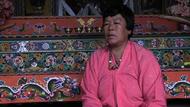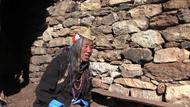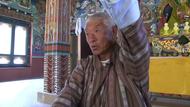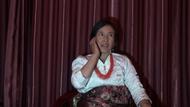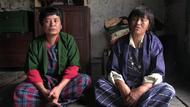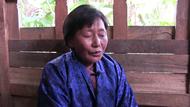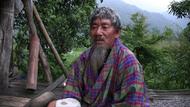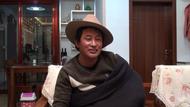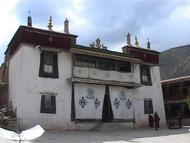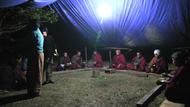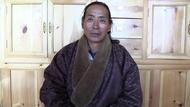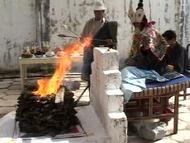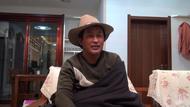Video Overview
In a series of over 20 videos, scholars read from and provide oral commentaries on the historical annals written by the Fifth Dalai Lama.
- Marpori
- Potala Palace
- Nepal
- Xi'an Shi
- India
- དེ་རིང་ངས་འདིར་ལྷན་རྒྱས་ལ་ཡ་ཞུ་ཡག་གཙོ་བོ་ག་རེ་རེད་ཟེར་ན། དེ་ཡིན་ཟེར། ཨོང་། བོད་ཀྱི་བཙན་པོ་སྐུ་ཐོག་སུམ་ཅུ་སོ་གསུམ་པ་སྲོང་བཙན་སྒམ་པོས་སྔ་རྗེས་སུ་རྒྱ་བཟའ་ཀོང་ཇོ་དང་བལ་བཟའ་ཁྲི་བཙུན་བཙུན་མོར་བཞེས་པ་སོགས་ཀྱི་སྐོར་ཡིན་ཟེར།The main topic that I am going to talk today to you folks is about how Songtsen Gampo, the 33rd King of Tibet accepted Kongjo, the Chinese princess and Tritsun, the Nepalese princess as [his] wives sequentially.
- དེའི་སྐོར་ལ་ཡ་དཔེར་ན་ཆ་བཞག་ན། ང་ཚོ་བོད་ཀྱི་ལོ་རྒྱུས་ཀྱི་ནང་ལ་ཡ་ཨ་ནི་ཅིག་བཀོད་པ་ཡིན་ན་ཞེ་དྲག་གི་མང་པོ་ཡོའོ་རེད་ཟེར། ཨོང་ལ་ལ། ད་དུང་ཡིན་ན་དེས་མ་ཚད་པ་ག་རེ་ཟེར་དགོས་རེད་། ང་ཚོ་བོད་ཀྱི་ས་ཕྱོགས་ག་ས་ག་ལ་ཡ་དམངས་ཁྲོད་ལ་ཡིན་ནའི་སྒྲུང་ཞེ་དྲག་སྙན་པོ་དེ་འདྲས་ཡིན་ན་ཡོའོ་རེད་ཟེར།For instance, there are many stories about this that are recorded in the history of Tibet. And moreover, there are also beautiful stories [about this that are kept] among the people everywhere in Tibet.
- ད་འདི་ཨོང་ག་རེ་རེད་ཟེར་ན། ད་སྒྲུང་དེ་ཚོ་ཡིན་ན་ཚང་མས་མཁྱེན་གྱི་རེད་། དམངས་ཁྲོད་ཀྱི་སྒྲུང་དེ་ཚོ་ཡིན་ན། ག་རེ་རེད་ཟེར་ན། ཨ་ནི་ཚང་མ་ཡིན་ན་ངག་རྒྱུན་ལ་དར་པ་ཀྱང་རེད་ཟེར། མི་རབས་གཅིག་ནས་མི་རབས་གཅིག་ལ་ཡ་བཤད་བྱས། འདུག་ཟེར། ཨོང་། ངག་རྒྱུན་ལ་དར་པ་ཀྱང་ཅིག་རེད་ཟེར། ཨ་ནི་བྱས་ཙང་ག་རེ་རེད་ཟེར་ན། ཨོང་། བྱས་ཙང་ག་རེ་རེད་ཟེར་ན། ཅིག་གི་ཨོའོ། སྲོང་བཙན་སྒམ་པོ་དང་། རྒྱ་བཟའ་ཀོང་ཇོ། བལ་བཟའ་ཁྲི་བཙུན་དེའི་སྐོར་ལ་ཡིན་ན་ཅིག་གི། ཨོང་། མང་ཚོགས་ཀྱི་ནང་ལ་་ཡིན་ནའི་ད་ཅིག་ རྒན་རབས་ཀྱི་ནང་ལ་ཡིན་ནའི་ཅིག་ དེའི་སྐོར་ལ་ཡ་སྒྲུང་འདི་ཤེས་མཁན་ད་ཅི་དག་ཞེ་དྲག་མང་པོ་བྱས་འདུག་ཟེར་ཡོའོ་རེད་ཟེར།Well, everybody knows these stories. These stories [that are kept] among people are all widespread in oral tradition. [These] are all told from generation to generation. [They] are all widespread in oral tradition. So that is why there are many older people who know [the story] about Songtsen Gampo, Kongjo, the Chinese princess, and Tritsun, the Nepalese princess.
- ད་ཨོང་། གོང་ལ་ཞུས་པ་ད། ཨ་ནི། བོད་ཀྱི་ལོ་རྒྱུས་དེབ་ཐེར་ནང་ལ་ཡ་བཀོད་ཡས་ཡིན་ན་ཞེ་དྲག་མང་པོ་རེད་དེ་ལའི། ཨོང་། ད་ཡིན་ནའི་ད་རེས་ཡིན་ན་ངས་འདི་ཡ་གཞི་བཅོལ་ས་འདི་གཙོ་བོ་ག་རེ་རེད་ཟེར་ན། འདི་ཡིན་ཟེར། ཨོང་ང་རང་ཚོའི། ཨོང་། རྒྱལ་བ་སྐུ་ཕྲེང་ལྔ་པ་ངག་དབང་བློ་བཟང་རྒྱ་མཚོས་རྩོམ་གནང་པའི། བོད་ཀྱི་དེབ་ཐེར་དཔྱིད་ཀྱི་རྒྱལ་མོའི་གླུ་དབྱངས་ཡིན་ན་བཞིར་བཞག་བྱས། འདུག་ཟེར་ལྷན་རྒྱས་ལ་ཞུ་ཡས་ཡིན་ཟེར།Even though there are many [stories] recorded in Tibetan historical accounts as mentioned before, I am going to explain [the story] to you folks based on the history book [called] Chyikyi Gyalmoi Luyang (The Melodious Songs of the Cuckoo by the Fifth Dalai Lama).
- ད་ཡིན་ན། ཨོང་། ཚང་མ་ལོག་གིས་མ་གཞི་མཁྱེན་གསལ་ལྟར་རེད། སྲོང་བཙན་སྒམ་པོ་ཡིན་ན་ག་རེ་རེད་ཟེར་ན། ཨ་ནི། སྲོང་བཙན་སྒམ་པོ་ཡིན་ན། ང་རང་ཚོའི་ད་། ཨོང་ ད་གིན་གོང་ལ་ཞུས་པ་ནང་གི་ནང་བཞིན་བོད་ཀྱི་ཨོང་། བཙན་པོ་ཡིན་ན། ཨོང་། སྐུ་ཐོག་ཡིན་ན་སུམ་ཅུ་སོ་གསུམ་པ་དེ་རེད་ལ། ཨ་ནི་ཁོ་རང་གིས་ཡིན་ན། སྲོང་བཙན་སྒམ་པོས་ཡིན་ན་སྤྱི་ལིའི་དུས་རབས་བདུན་པའི་ནང་ལ་ཡ་ཡིན་ན། བོད་ཡོངས་ཡིན་ན་གཅིག་གྱུར་བཟོས་གནང་པ་དང་། བོད་ལ་ཡ་ཡིན་ན་གཅིག་གི། ཨོང་བོད་ལ་ཡ་སྐབས་དེ་དུས་སྤྱི་ཚོགས་ཀྱི་སྒྲིག་གཞི་དང་། ཐོག་མའི་ཁྲིམས་སྲོལ་ཡིན་ན་གཏན་ལ་ཕབ་གནང་པ། ཨ་ནི་ད་དུང་ཡིན་ན། ད་ལྟ་ང་རང་ཚོས་བེད་སྤྱོད་བཏང་བཞིན་པའི་བོད་ཡིག་དེ་ཡིན་ན་གསར་གཏོད་གནང་ཡས་དང་།As you all know, Songtsen Gampo, as mentioned before, was the 33rd King of Tibet. He, Songtsen Gampo, unified the whole Tibet in 7th century. [He] established rules and regulations for the first time in Tibet during that time. The Tibetan scripts that we use these days were invented [during his time] also.
- ཨ་ནི་ད་དུང་ཡིན་ན་ག་རེ་རེད་ཟེར་ན། དམིགས་ཡུལ་ལྡན་པའི་སྒོ་ནས་ཡིན་ན། ཨ་ནི་ཨོང་། བརྙན་འཕྲིན་གྱི་འབྲེལ་བ་དེ་འདྲས་གཙུགས་གནང་། གཙུགས་གནང་པ། ཨ་ནི་དེ་བཞིན་ཡིན་ན། ཨོང་། ཆབ་སྲིད་ཀྱི་ཅིག། ཆབ་སྲིད་ཡིན་ན་མཐའ་བཞི་ལ་ཡ་རྒྱ་བསྐྱེད་གནང་བྱས་ཡིན་ན། བོད་ཀྱི་དཔལ་འབྱོར་ཡིན་ན་གོང་འཕེལ་ཡིན་ན་གཏང་གནང་ཡས། ཨ་ནི་ད་དུང་ཡིན་ན་ཅིག་ང་རང་ཚོའི། ཨོང་། ལྷ་སའི་འདིའི་གཙུག་ལག་ཁང་ལ་སོགས་པ། ཨོང་། ཅིག་གཙུག་ལག་ཁང་བཞེངས་གནང་ནས་ཡིན་ན། ཨ་ནི་བོད་ལ་ཡ་ཡིན་ན་ཨོའོ། ནང་ཆོས་སྲོལ་གཏོད་གནང་པ་སོགས། ད་ཁོ་རང་གི་ཨོའོ། ཅིག་མཛད་རྗེས་ཡིན་ན་ཞེ་དྲག་གི་ཆེན་པོ་རེད་ཟེར།And also, based on his broader vision, communications through mailing system were established [during this time]. And in terms of political power, [he] extended it to four different directions. [He] improved economy in Tibet. And also, [he] built the Jokhang Temple in Lhasa. [It was during his time], Buddhism was introduced to Tibet. So, his accomplishments are great.
- དེ་འདྲས་སོང་ཙང་། དེང་། དེང་སང་གི་དུས་ལ་ཡིན་ནའི་བོད་མི་རིགས་ཚང་མས་ཡིན་ན། ད་སྲོང་བཙན་སྒམ་པོ་ལ་ཡ་ཡིན་ན། ཨོང་། དད་གུས་དང་དད་སེམས་ཡིན་ན་ཞེ་དྲག་གི། ད་ཁོ་རང་ལ་ཡ་ཅིག་ག་རེ་ཟེར་དགོས་རེད་། ད་དད་སེམས་དཔག་ཏུ་མེད་པ་དེ་འདྲས་ཞུ་གི་ཡོའོ་རེད་ཟེར། ཨ་ནི་ཁོ་རང་གི་མཚན་སྙན་གྲགས་ཡིན་ནའི་དུས་ད་ལྟའི་བར་ལ་ཡ་མ་ཉམས་པར་ཡ་ད་གནས་དང་གནས་མུས་བྱས་ད་འདུག་ཟེར་རེད་ཟེར།So, even to this day, all Tibetan people show immeasurable respect for Songtsen Gampo. And his fame has not degenerated even to this day, and it is still being [recognized].
- ད་ཁོ་རང་གི་རླབས་ཆེན་གྱི་མཛད་པ་ཡིན་ན། ཨོང་། ཅིག་གི། ག་རེ་ཞུ་དགོས་རེད། ཅིག་གི་བསམ་གྱིས་མ་ཁྱབ་པ་དང་། ཞུས་ནའང་ཞུ་ཚར་ཡས་ཡོའོ་མ་རེད་དེ་ལའི། ད་ཞུས་ད་ཞུས་ཚར་ཡས་ཡོའོ་མ་རེད་ཟེར། ད་ཡིན་ནའི་ངས་ད་གིན། ཨོང་། ལྷན་རྒྱས་ལ་ཡ་གོང་ལ་ཞུས་པ་ལྟར་རེད་། ད་ལྟ་ང་རང་ཚོས་ཞུ་ཡས་དེ་གཙོ་བོ་དེ་ཡིན་ན། སྲོང་བཙན་སྒམ་པོས་སྔ་རྗེས་སུ་ཡིན་ན། ཨ་ནི་བཙུན་མོ་ཡིན་ན་རྒྱ་བཟའ་ཀོང་ཇོ་དང་། བལ་བཟའ་ཁྲི་བཙུན་བཞེས་པ་འདིའི་སྐོར་ཡིན་ཟེར།Even though his great accomplishments are unimaginable and could not be explained if [we ] were to explain them, but as mentioned previously the main topic that we are going to talk today is regarding how Songtsen Gampo accepted Kongjo, the Chinese princess, and Tritsun, the Nepalese princess over time.
- ད་ཡིན་ནའི་ཨོང་། ག་རེ་ཟེར་དགོས་རེད། ཚང་མ་ཅིག་གིས་ལོ་རྒྱུས་ལ་སློབ་སྦྱོང་གནང་ཉན་༼མཁན་༽དང་། ལོ་རྒྱུས་ཞིབ་འཇུག་གནང་ཉན་༼མཁན་༽ཡིན་ན། ཚང་མས་ཡིན་ན་འདུག་ཟེར་མཁྱེན་གྱི་རེད་ཟེར། ད་སྲོང་བཙན་སྒམ་པོས་ཡིན་ན། ཨ་ནི་བཙུན་མོ་ཡིན་ན། ད་ད་ལྟ་ང་ཚོས་གོང་ལ་ཞུས་པ་ལྟར་རྒྱ་བཟའ་ཀོང་ཇོ་དང་། བལ་བཟའ་ཁྲི་བཙུན། ཨོང་ཁོང་རྣམས་གཉིས་གཅིག་པོ་བཞེས་པ་དེ་འདྲས་ཅིག་མ་གཞི། བཙུན་མོ་གཞན་དག་དེ་འདྲས་མེད་པ་རེད་པས་ཟེར་ན། མ་རེད། ད་འདི་ང་རང་ཚོས་ལོ་རྒྱུས་ཞིབ་འཇུག་གནང་མཁན་ཚོས་མཁྱེན་གྱི་རེད་པཱ།But, if you are those who study or do research in Tibetan history, all of you will know this. It is not the case that Songtsen Gampo had only Kongjo, the Chinese princess and Tritsun, the Nepalese princess as his wives. Those of you who do research in [Tibetan] history obviously know this case.
- དཔེར་ན་ཆ་བཞག་ན། འདུག་ཟེར་རེད་པཱ་ལགས། ད་ཅིག་གི་ཨོང་། སྤྱི་ལོའི་དུས་རབས་བདུན་པའི་ནང་ལ་ཡ་ཡིན་ན། སྲོང་བཙན་སྒམ་པོའི་ད་ཐུགས་ལ་ཡ། བོད་ཡུལ་ཁ་བ་ཅན་གྱི་ད་མི་དེ་གས་ཅིག་གི། བོད་ཡུལ་ཁ་བ་ཅན་དེ་ནམ་ཡང་ཡིན་ན། ཕན་བདེའི་ཨོའོ་ཅིག་གི། ཨོའོ་དཔལ་ལ་ཡ་ལོངས་སྤྱོད་ཡས་ཅིག་དང་། མངའ་ཐང་ཡིན་ན་མི་ཉམས་པ་གོང་འཕེལ་ཡོང་ཡས། ཨ་ནི་བཙན་པོའི་ཆབ་སྲིད་ཡིན་ན་མི་ནུབ་པ། ཨ་ནི་ང་རང་ཚོའི་ཅིག་གི་མི་ནུབ་པ་ཡིན་ན་ཡུལ་ལ་ཅིག་གི་བརྟན་པོ་བྱས་བསྡད་དགོས་པ་ཡིན་ན། གདུང་བརྒྱུད་སྤེལ་ཡས་འདི་ཞེ་དྲག་གི་གལ་ཆེན་པ་རེད་ཟེར།For instance, this is the case: in 7th century Songtsen Gampo saw the great importance of disseminating his family lineage in order to [make] Tibet prosperous forever, to keep his ruling power strong, to keep the political rule alive without being degenerated.
- བྱས་ཙང་གདུང་བརྒྱུད་ཨ་ནི་དེ་འདྲས་ཅིག་གི། ཅིག་གི་བརྒྱུད་འཛིན་གྱི་གདུང་བརྒྱུད་ཅིག་ཡོང་ཡས་ཆེད་དུ་། ཨ་ནི་སྲོང་བཙན་སྒམ་པོས་ཡིན་ན། ད་ལྟ་ཅིག་གོང་ལ་ཞུས་པའི་རྒྱ་བཟའ་ཀོང་ཇོ་དང་། བལ་བཟའ་ཁྲི་བཙུན་ཕུད་ནས། ད་དུང་ཡིན་ན་བཙུན་མོ་གསུམ་བཞེས་ཡོའོ་རེད་པཱ། བཙུན་མོ་གསུམ་འདི་ཨ་ནི་ག་རེ། ཁོང་རྣམས་ཚོའི་མཚན་ལ་ག་རེ་ག་རེ་ཟེར་གྱི་ཡོའོ་རེད་ཟེར་ན།So, in order to maintain such a family lineage, in addition to Kongjo, the Chinese princess and Tritsun, the Nepalese princess, Songtsen Gampo also had three other wives. Their names are as follows:
- གཅིག་ཡིན་ན་འདི་རེད་ཟེར། ང་རང་ཚོའི་ཅིག། ཨོང་མོང་བཟའ་ཁྲི་ལྕམ་བྱས། གཅིག་ཡིན་ན་ཨོང་། སུ་རེད་ཟེར་ན། ཞང་ཞུང་བཟའ་༼ཟེར༽ལི་མིག་དམན་བྱས། གཅིག་ཡིན་ན་ག་རེ། སུ་རེད་ཟེར་ན། ཨོའོ་མིའི་དབྱང་། ཨོའོ་མིའི་དབྱང་ཡིན་ན་རོའོ་དབྱུང་བཟའ་༼ཟེར་༽བྱས། དེ་གས་ཁོང་རྣམ་ཚོ་གསུམ། ད་འདུག་ཟེར་བཞེས་ཡོའོ་རེད་ཟེར། ད་ཁོང་ཚོ་གསུམ་ཡིན་ན་ག་རེ་རེད་ཟེར་ན། ད་གོང་ལ་ཞུས་པའི་བཙུན་མོ་གསུམ་འདི་རྒྱ་བཟའ་ཀོང་ཇོ་དང་། བལ་བཟའ་ཁྲི་བཙུན་མ་བཞེས་གོང་ལ་ཡ་འདུག་ཟེར་ཅིག་བཞེས་པ་རེད་ཟེར།Well, one is Tricham, the wife from Mong; one is Limig Men, the wife from Zhang Zhung; and one is Royung, the wife from Royang. These three are all [Songtsen Gampo's] wives. He had had the three wives mentioned here before he took Kongjo, the Chinese princess and Tritsun, the Nepalese princess as his wives.
- ད་ད་ལྟའི་ཅིག་གི་གོང་ལ་ཞུས། འདུག་ཟེར་རེད། ད་ཡིན་ནའི་ད་ལྟ་ཨོང་། ག་རེ་ཞུ་དགོས་རེད་། ང་ཚོས་ད་ལྟ་ང་ཚོས་ད་རེས་ཀྱི་ནང་དོན་འདི་ཡིན་ན། ད་འདི་གཙོ་བོ་འདི་རྒྱ་བཟའ་ཀོང་ཇོ་དང་བལ་བཟའ་ཁྲི་བཙུན་བཞེས་པའི་སྐོར་འདི་མར་ཞུ། ཞུ་ཡས་སོང་ཙང་། ཨ་ནི་གཤམ་ལ་ཡ་མུ་མཐུད་བྱས་ཡིན་ན། ཨ་ནི་འདུག་ཟེར་ཨོའོ་ཞུ་གི་ཡིན་ཟེར། ད་འདི་ག་རེ་རེད་ཟེར་ན། ཨོང་། དེ་འདྲས་གཅིག་རེད་པཱ་ལགས། ཅིག་གི་སྲོང་བཙན་སྒམ་པོ་ཡིན་ན། ཁོ་རང་ཡིན་ན་ཅིག་གི། ག་རེ་ཟེར་དགོས་རེད་། ཁོ་རང་ཡིན་ན་ཨོང་ཅིག་གི། སྤྱན། ད་ཅིག། ཁོ་རང་གི་སྤྱན་རྒྱང་ཡིན་ན་རིང་པོ་ཡོད་པ། སྤྱན་རྒྱང་ཡིན་ན་ཞེ་དྲག་གི་རིང་པོ་དང་ཅིག་ཐག་རིང་པོ་ནས་ཅིག། དེ་འདྲས་ཀྱི་གཟིགས་ཐུབ་མཁན་གྱི། ཁོ་རང་ཡིན་ན་ཨོང་ཅིག། མཁྱེན་རྒྱ་དང་ཅི་དག་གང་ལ་ཡ་མཁྱེན་བསླབ་མཆོག་ཏུ་མངའ་བའི་བཙན་པོ་དེ་འདྲས་གཅིག་སོང་ཙང་།This is [a brief account of his three other wives.] Since our main topic is about how [Songtsen Gampo] took Kongjo, the Chinese princess, and Tritsun, the Nepalese princess, [I] am going to continue speaking about it in the following [lecture]. Songtsen Gampo had a broad vision. [He] could plan way, way ahead of time. Since [he] was a person with a great vision and a great knowledge
- ཨ་ནི་ཁོ་རང་གི་ད་ཐུགས་ལ་ཡ། ག་རེ། ད་ཨོང་། སྐབས་དེ་དུས་ཁོ་རང་གི་ཐུགས་ལ་ཡ་ག་འདྲས་ཅིག་དགོངས་ཡོའོ་རེད་ཟེར་ན། ད་བོད་ཁ་བ་ཅན་གྱི་ཡུལ་འདི་ཡིན་ན། སངས་རྒྱས་ཀྱི་བསྟན་པ་ཡིན་ན་ཉི་མ་ཤར་པ་དང་། དར་ཞིང་རྒྱས་པ་ཡོང་པ་ཡིན་ན་ད་ཅིག་རྒྱ་ནག་དང་། བལ་ཡུལ་ནས། ཨོང་། ད་ཅིག། བཙུན་མོ་ད་ཅིག། ཨོའོ་དེ་། བཙུན་མོ་གཉིས་ད་འདུག་ཟེར་བཞེས་ཐུབ་པ་ཡིན་ན། ཨ་ནི་གཅིག་ནས་ཡིན་ན། ཨོང་། ནང་ཆོས་ཡིན་ན་ཅིག་བོད་ལ་དར་ཡས་ལ། བོད་ཁ་བ་ཅན་ལ་དར་ཡས་ལ་ཕན་ཐོགས་ཡོད་པ་དང་གཅིག།he thought during this time that in order for Buddhism to spread far and wide in the Snow Land Tibet like the sun, if he could take the two princesses from China and Nepal, it would help spread Buddhism in Tibet, the Snow Land on the one hand.
- གཉིས་ནས་ཡིན་ན་ག་རེ་རེད་ཟེར་ན། འདི་རེད་ཟེར། ཡུལ་འདི་དག་གི་ད་ཕུན་སུམ་ཚོགས་པའི་རིག་གནས་ཡིན་ན། ཨ་ནི་དེ་གས་དེ་ཡིན་ན་ཚུར་ཡིན་ན་ཨོང་ཅིག། ང་རང་ཚོས་ལེན་ཐུབ་ཀྱི་རེད། འདུག་ཟེར་དགོངས་ནས། ཨ་ནི་ཨོང་། འདི་ག་རེ་ཟེར་དགོས་རེད། ད་ཁོ་རང་གི་དགོངས་པ་འདི། ཨ་ནི་ཅིག་བློན་པོ་ཚོས་ད་ཅིག་དང་ལེན་དང་། ད་ཅིག་བྱེད་ཡས་ཀྱི་ཆེད་དུ་ཨ་ནི་ག་རེ་རེད་ཟེར་ན།On the other hand, [he] thought that they could bring in the marvelous cultures of these [two] countries. So, what did he do in order to convince his ministers to agree with his idea?
- ད་ཁོ་རང་གི་བཙུན་མོ་དེ་གཉིས་བཞེས་ཡས་ཀྱི་ད་ཅིག་ཐུགས་ཐག་བཅད་པ་འདིའི་དགོངས་པ་འདི། ཨ་ནི་བློན་པོ་ཚོ་ལ་གསུངས་དུས་ག་འདྲས་ཟེར་གསུངས་པ་རེད་ཟེར་ན། ད་ང་ཨ་ནི་མདང་དགོང་ད་གཉིད་༼རྨི༽ལམ་གཅིག་བཏང་བྱུང་ཟེར། ཁོང་ཚོ་བློན་པོ་དེ་ཚོ་ལ། ད་ང་གཉིད་༼རྨི་༽ལམ་ཡག་པོ་ཞེ་པོ་གཅིག་བཏང་བྱུང་ཟེར། ད་གཉིད་ལམ་འདི་ག་རེ་རེད་ཟེར་ན། ཨ་ནི་ག་རེ་རེད་ཟེར་ན་ད་ཅིག། ཨོང་ཅིག་གི། ཅིག་གི་ད་གཉིད་༼རྨི༽ལམ་འདིའི་ནང་ལ་ཡ་ཡིན་ན། ང་ཡིན་ན་ལུང་བསྟན་གཅིག་ད་དེ་འདྲས་གཅིག་གནང་བྱུང་ཟེར།So, how did [he] convey his decision about taking these two wives to [his] ministers? He said: I had a dream last night. I had a very good dream. I had a prophesy in my dream.
- ད་འདི་ག་རེ་རེད་ཟེར་ན། ཨ་ནི་ཐང་རྒྱལ་རབས་ལ་ཆ་བཞག་པ་ཡིན་ན། ད་སྟོན་པ་ཡིན་ན་ཤཀྱ་ཐུབ་པ་ཡིན་ན་དགུང་ལོ་ཡིན་ན། ཨ་ནི་བརྒྱད་། བརྒྱད་ལ་ཕེབས་པའི། ཨ་ནི། ཅིག། སྐུ་འདྲ་གཅིག་ཡོད་པ་དང་། ཨ་ནི་ཨོང་། བལ་ཡུལ་ལ་ཆ་བཞག་པ་ཡིན་ན། ཨ་ནི་ཅིག་གི་ཨོང་། སངས་རྒྱས་ཀྱི། ཅིག། བཅོམ་ལྡན་འདས་དགུང་ལོ་ཡིན་ན། ཨོང་། ཨ་ནི།This is what the [prophecy] is: The Tang Dynasty has a statue of an eight-year-old Buddha, and Nepal has a statue of the Buddha who is...years old.
- སྲོང་བཙན་སྒམ་པོ་ཁོ་རང་གིས། ད་འདི་ག་རེ་ཟེར་དགོས་རེད། བཙུན་མོ། ཨ་ནི་གོང་དུ་ཞུས་པའི་བཙུན་མོ་གཉིས་བཞེས་ཡས་ཀྱི། ད་འདི་ཁོ་རང་གི་དགོངས་པ་ཡིན་ན་འདུག་ཟེར་འཁོར་པ་དང་། ཁོ་རང་གིས་ཐུགས་ཐག་བཅད་གནང་པ་རེད། ད་ཡིན་ནའི་འདི་ཁོ་རང་གི་དགོངས་པ་འདི་བློན་པོ་ཚོས་ཡིན་ན། ཅིག་གི་ཨོའོ་ཤེས་རྟོགས་ཡག་པོ་ཡོང་ཡས་དང་། ད་ཅིག་དེ་འདྲས་ཀྱི་ཆེད་དུ་ཨ་ནི་ག་རེ་རེད་ཟེར་ན། ཁོ་རང་གི་ཡིན་ན་ད་འདི་བློན་པོ་ཚོ་ལ་ཡ། ད་ཁོ་རང་ལ་ཡ་གཉིད་༼རྨི་༽ལམ་བཏང་པའི་ཁུལ་བྱས་བྱས་འདུག་ཟེར་གསུངས་པ་རེད་ཟེར།This was the reason why Songtsen Gampo thought about taking the two princesses mentioned above as his wives. [He] made the decision. However, [he] expressed his idea as if he had a dream so that the ministers would believe in his plan.
- ཨ་ནི་སང་ཉིན་དེར་བློན་པོ་ཚོ་ལ་ཡ། ད་ཨ་ནི་མདང་དགོང་ང་གཉིད་༼རྨི་༽ལམ་ཡིན་ན། ད་ཅིག། ཨོང་། ཅིག་ཡ་མཚན་ཅན་གྱི་ད་རྨི་ལམ་གཅིག་ཁྱད་དེ་འདྲས་གཅིག་བཏང་བྱུང་ཟེར། ད་རྨི་ལམ་དེའི་ནང་ལ་ཡ་ལུང་བསྟན་ཡིན་ན་ད་ཅིག། ཨོང་། ལུང་བསྟན་ཡིན་ན། ཨོའོ་དམིགས་བསལ་གྱི་ལུང་བསྟན་གཅིག་བྱུང་ཟེར། ཨ་ནི་ག་རེ་རེད་ཟེར་ན། ད་འདི་ཡིན་ན་ཨ་ནི་ཨོང་། དཔེར་ན་འདི་རེད་ཟེར། ག་རེ་ཟེར་དགོས་རེད་། ཨོང་དེ་ཅིག་གི་བལ་ཡུལ་དང་ཨ་ནི་ཐང་རྒྱལ་རབས་ནས། ཨ་ནི་ཨོའོ་དེ་ཅིག། སྟོན་པ་ཡིན་ན་ད་ཤཀྱ་ཐུབ་པ་དགུང་ལོ་བརྒྱད་པ་དང་དགུང་ལོ་བཅུ་གཉིས་པའི་ཨ་ནི་སྐུ་ཚད་ཅན་གྱི། ཨ་ནི་ཨོང་། སྐུ་གཅིག་ཡོད་པ་འདི་བོད་ལ་ཡ་ཨ་ནི་གདན་འདྲེན་ཞུ་ཐུབ་པའི་ཆེད་དུ། ཨ་ནི་ག་རེ་རེད་ཟེར་ན། ཨོང་། བལ་ཡུལ་དང་ཐང་རྒྱལ་རབས་ནས་བཙུན་མོ་གཉིས་བསུས་པ་ཡིན་ན། ཨ་ནི་ད་ལྟ་གོང་དུ་ཞུས་པའི་ཨ་ནི་སྟོན་པ་ཤཀྱ་ཐུབ་པའི་སྐུ་ཚད་། ཨོའོ་དགུང་ལོ་བརྒྱད་ལ་ཕེབས་པའི་སྐུ་ཚད་དེ་དང་། དགུང་ལོ་ཡིན་ན་བཅུ་གཉིས་ལ་ཕེབས་པའི་སྐུ་ཚད་དེ་གཉིས་གཉིས་ཨ་ནི་བཙུན་མོ་གཉིས་ཀྱི། ཨ་ནི་ཅིག་གི་ ཨ་ནི་རྟེན་གྱི་སྐལ་བྱས་བྱས་བོད་ལ་ཡ་བསྣམ་ཐུབ་ཀྱི་རེད་བྱས། དེ་འདྲས་ཀྱི་ང་ཡ་རྨི་ལམ་ངོ་མཚར་ཅན། དེ་འདྲས་གཅིག་བཏང་བྱུང་ཟེར།So, the next day [he] told the ministers that he had an extraordinary dream the previous night. [He] said that he received a special prophecy in his dream. [He] said that this was the [prophecy]: in order to bring the statues of the 8-year-old Buddha and 12-year-old Buddha from the Tang Dynasty and Nepal to Tibet, if the two princesses from the Tang Dynasty and Nepal were invited [we] could bring in the statue of the 8-year-old Buddha and the statue of the 12-year-old Buddha to Tibet as their dowries. [He] said that he had this extraordinary dream.
- ཨ་ནི་འདི་འདུག་ཟེར་བྱས་བྱས་གསུངས་པ་རེད་ཟེར། ཨ་ནི་འདུག་ཟེར་གསུངས་དུས་ཙམ་ནས། ཨ་ནི་འདིའི། གལ་སྲིད་ངའི་ཡིན་ན་ད་འདི་ག་རེ་ཟེར་དགོས་རེད་། ཨོའོ་འདུག་ཟེར་བྱས་བྱས་ཁོ་རང་གིས་འདུག་ཟེར་གསུངས་པ་རེད་ཟེར། ཨ་ནི་གསུངས་ནས་ག་རེ་རེད་ཟེར་ན། ད་འདི་ཁོ་རང་གི་རྨི་ལམ་འདི་གསུངས་ཡས་འདི་དོན་དངོས་ཐོག་ལ། ག་རེ་རེད་ཟེར་ན། སྲོང་བཙན་སྒམ་པོ་ཁོ་རང་གི། ཨོའོ། དགོངས་པ་འདི། ད་བློན་པོ་རྣམས་ལ་ཁྱབ་བསྒྲགས་གནང་པ་ནང་བཞིན་ཅིག་རེད་ཟེར།This was what he said. As [he] said this... This was what he said. The main reason why he explained this as his dream was because Songtsen Gampo wanted to announce his plan to the ministers [as if it was a prophecy].
- ཨ་ནི་འདུག་ཟེར་སྲོང་བཙན་སྒམ་པོས་མར་གསུངས་ཚར་དུས་ཙམ་ནས། སྲོང་བཙན་སྒམ་པོས་གསུངས་ནས། ག་རེ་ཟེར་དགོས་རེད་གོ། ཁོ་རང་གི་དགོངས་པ་འདི་མར་གསུངས་ནས། ཨ་ནི་སྲོང་བཙན་སྒམ་པོའི་ཡིན་ན་གྲགས་ཅན་གྱི་བློན་པོ་ཨ་ནི། ཨོའོ་མགར་སྟོང་བཙན་དང་། ཨོའོ་ད་དེ་ནས་ཐུན་མི་སམ་བྷོཊ་ལ་སོགས་པ་ཡིན་ན་ཨ་ནི་ཚང་མ་ལོག་གི་ཡིན་ན། ད་འདི་ཨོང་ཁོང་ཚོས་ཡིན་ན། སྲོང་བཙན་སྒམ་པོས་གི་གསུངས་པ་འདི་ཡིན་ན། ཁོང་ཚོས་ཡིན་ན་དོ་སྣང་ད་ཅི་དག་ཞེ་དྲག་གི་ཆེན་པོ་བྱས་པ་རེད་ཟེར།After Songtsen Gampo made his announcement, his famous ministers such as Gar Tongtsen, Thumi Sambhota, etc. showed great interest in what Songtsen Gampo announced.
- ལྷག་པར་དུ་མགར་སྟོང་བཙན་གྱིས་ཁོ་རང་གིས་འགན་ཁྱེར་བྱས། ད་བློན་པོ་གཞན་དག་དང་གྲོས་བསྡུར། ད་ཅིག་གྲོས་མོལ་བྱས་བྱས། ད་འདི་ཨོང་། བཙན་པོས་གསུངས་པ་འདི། ད་ང་རང་ཚོས་གང་འདྲས་ཟེར་བྱས་ན་ཡག་གི་རེད། འདུག་ཟེར་བྱས་བྱས་ཁོང་ཚོས་གྲོས་མོལ་བྱས་པ་རེད་ཟེར།Gar Tongtsen, in particular, took the responsibility and discussed with other ministers regarding the best way to carry out the plan that the emperor mentioned.
- ཨ་ནི་དེ་ནས་ཡིན་ན་ད། ཨོང་། བློན་པོ་མགར་གྱིས་ཡིན་ན་གཙོ་བོ་གི་ང་རང་། སྐབས་དེ་དུས་ཀྱི་བཙན་པོའི་རྒྱལ་རབས་ཀྱི་བློན་པོ་གཙོ་བོ་མི་བདུན་དང་། ཨོའོ་ད་གཙོ་བོ་མི། བློན་པོ་མི་བདུན་གྱིས་གཙོ་བོ་བྱས་པའི་བློན་པོ་ཚོ་དང་། ཨ་ནི་ཨོའོ་དེ་ཅིག། གྲོས་མོལ་བྱས་ནས་ད་བློ་གྲོས་ཀྱི་ཐབས་བྱུས། རྦད་དེ་ད་ཅིག་ག་རེ་ཟེར་དགོས་རེད། ངོ་མཚར་ལྡན་པ་ཁ་ཤས་ཅིག་ཁོང་ཚོས་ཡིན་ན་ད་དེ་འདྲས་ཟེར་གཏན་ལ་འཁེལ་ནས། ཨ་ནི་སྲོང་བཙན་སྒམ་པོ་ཡ་ལམ་སང་སྙན་གསང་ཞུས་པ་རེད་ཟེར།And then the minister Gar discussed [the matter] with other ministers, primarily with the seven chief ministers and agreed upon some brilliant decisions. And then [they] reported it to Songtsen Gampo.
- ད་ཁོང་ཚོས་དེ་འདྲས་ཟེར་ད། གནང་ན་ཡག་པོ་འདུག་ཟེར་ཡས་དེ་འདྲས་ཀྱི་ཅིག་ཇུས་དེ་འདྲས་བཏོན་བྱས་སྲོང་བཙན་སྒམ་པོ་ཡ་ཞུས་པ་རེད་ཟེར། ཨ་ནི་ཞུས་ནས་ཡིན་ན། སྲོང་བཙན་སྒམ་པོ་ཡིན་ན་ཞེ་དྲག་མཉེས་པོ་བྱུང་བྱས། ཨོའོ། ད་ཡག་པོ་ཞེ་དྲག་བྱུང་བཞག་ཟེར། ཁྱེད་རང་ཚོས་གསུངས་པ་འདི། ཁྱེད་རང་ཚོས་ག་རེ་ཟེར་དགོས་རེད། གྲོས་བསྡུར་བྱས་པ་འདི། ཨོའོ་ཁྱེད་རང་ཚོས་གྲོས་མོལ་བྱས་པ་འདི་ཡག་པོ་ཞེ་དྲག་བྱུང་བཞག་ཟེར།They came up with some strategies suggesting to do [certain things] and reported them to Songtsen Gampo. Songtsen Gampo was very delighted with their suggestions and said that they were very good. [He] said that [the matters] that they discussed were extremely good.
- སྲོང་བཙན་སྒམ་པོས་འདུག་ཟེར་བཀའ་གཅིག་འདུག་ཟེར་ཕེབས་༼ཕབ༽པ་རེད་ཟེར། ཨ་ནི་བཀའ་ཕེབས་ཙང་ད་ཁོང་ཚོས་ག་རེ་བྱས་པ་རེད་ཟེར་ན། ཨ་ནི་སྔན་༼སྔོན་༽ལ་ཡ་ད་གནའ་མ། ཅིག། བཙུན་མོ་བསུ་ཡས་ཀྱི་ད་ཁོང་ཚོ་ཡིན་ན་ལས་ཀ་འདི་སྒྲ་སྒྲིག་བྱས་པ་རེད་ཟེར། ད་སྒྲ་སྒྲིག་བྱས་ནས་སྔན་ལ་ཡ་ག་རེ་བྱས་པ་རེད་ཟེར་ན། བཙུན་མོ་གཉིས་ཀྱི་ནང་ནས། སྔན་ལ་ཡ་ཨ་ནི་བལ་ཡུལ་ནས་ཨ་ནི་བལ་བཟའ་ཁྲི་བཙུན་བསུ་རྒྱུ་དེ་ཡིན་ན་སྔན་ལ་ཡ་འདུག་ཟེར་ཐག་གཅད་པ་རེད་ཟེར།Songtsen Gampo gave an order. Because of that, what they did was they first made an arrangement to invite the princesses as [Songtsen Gampo's] brides. The first thing that they did was they made the decision to invite Tritsun, the Nepalese princess, amongst the two princesses, from Nepal first.
- ཨ་ནི་ཐག་གཅད་ནས་ཡིན་ན། དེ་ནས་ཡིན་ན་ད་ཅིག་གི། ཨོའོ། མགར་སྟོང་བཙན་ཡུལ་སྲུང་དང་། ཐུན་མི་སམབྷོཊ་གཉིས་ཀྱིས་ཁོང་གཉིས་གཉིས་ཀྱིས་སྣེ་ཁྲིད་པའི་བློན་པོ་ཡིན་ན། ད་ཨོང་། བོད་ནས་ཡིན་ན་བློན་པོའི་ཡིན་ན་འཁོར་ཡིན་ན་རྟ་པ་བརྒྱ་ལྷག་ཙེ་༼ཙམ་༽གཅིག། ཨ་ནི་བལ་ཡུལ་ཡ་འདུག་ཟེར་ཨོའོ་ཕྱིན་བྱས། ཨ་ནི། ཨོའོ། འདུག་ཟེར་ད་བཙུན་མོར་ཡར། ཨ་ནི་བལ་བཟའ་ཁྲི་བཙུན་ཡིན་ན་ད། ཨོང་། བལ་པོའི་རྒྱལ་པོར་ཡ་གསོལ་རས་ཞུ་གར་འདུག་ཟེར་ཕྱིན་པ་རེད་ཟེར།After they made the decision, Gar Tongtsen and Thumi Sambhota leading more than hundred horsemen as entourage travelled to Nepal from Tibet. This is how [they] went to ask the Nepalese king for Tritsun, the Nepalese princess.
- ད་ང་རང་ཚོའི་དེ་ཡ་ད་ལྟ་ག་རེ་ཟེར་དགོས་རེད། རྟ་པ་ཨོའོ་བརྒྱ་ལྷག་ཙེ་༼ཙམ་༽ཅིག་བཏང་པ། ད་ལྟ་འདི་མགར་སྟོང་བཙན་དང་། ཐུན་མི་སམབྷོཊས་སྣེ་ཁྲིད་པའི་རྟ་པ་བརྒྱ་ལྷག་ཙེ༼ཙམ་༽ཅིག་བལ་ཡུལ་ཡ་ཕྱིན་པ་རེད་ཟེར་བྱས། ད་ལྟ་ངས་གོང་ལ་ཞུས་ཡས་ཅིག་ཡོའོ་རེད་པཱ་ལགས། ད་འདི་ང་རང་ཚོའི་ལོ་རྒྱུས་ཀྱི་དེབ་ཐེར་ཁག་ཁ་ཤས་ཀྱི་ནང་ལོགས་ཡ། ད་ང་ཚོས་ག་རེ་བྲིས་ཡོའོ་རེད་ཟེར་ན། དེའི་ནང་ལ་ཡ་དེ་འདྲས་བྲིས་ཡོའོ་རེད། ད་འདིའི་ག་རེ་ཟེར་དགོས་རེད་། རྟ་པ་བརྒྱ་ད་ག་རེ་རེད། སྲོང་བཙན་སྒམ་པོས་སྤྲུལ་པ་བསྟན་བྱས། ད་སྤྲུལ་པ་བསྟན་བྱས། སྤྲུལ་པའི་ད་དེ་འདྲས་ཀྱི་རྟ་པ་རེད་ཟེར།I just mentioned that there were over one hundred horsemen led by Gar Tongtsen and Thumi Sambhota to Nepal, right? In some of the history books it is mentioned that Songtsen Gampo emanated those hundred horsemen. So, [it is said that] they were emanated horsemen.
- ད་སྤྲུལ་པ་བསྟན་གནང་བྱས་འདུག་ཟེར་སླེབས་པ་རེད་ཟེར། ད་ང་རང་ཚོ་ཁག་གཅིག་གིས་ཡིན་ན་དེ་འདྲས་ཟེར་ཟེར་སྲོལ་ཡོའོ་རེད་། གང་ལྟར་ཡིན་ན་ག་རེ་རེད་ཟེར་ན། ཨ་ནི་ཨོང་། འདུག་ཟེར། བཙུན་མོ་བསུ་ཡས་ཀྱི། དེ་ཅིག་གི། རྟ་པ་དེ་ཡིན་ན་ཞེ་དྲག་གི་ཅིག་གི་ག་རེ་ཟེར་དགོས་རེད། ཨོང་། ཅིག་སྒྲ་སྒྲིག་ཡོད་པ་དང་། རྒྱ་ཆེན་པོ་བྱས་བྱས་ཡིན་ན་ཁོང་ཚོ་འདུག་ཟེར། ཨོང་། ད་བཙུན་མོར་ཡ་འདུག་ཟེར་གསོལ་རས་ཞུ་གར་ཐད་པ་རེད་ཟེར། ད་བཙུན་མོ་གསོལ་རས་ཞུ་གར་འགྲོ་དུས་ཙ་ནས། ཨ་ནི། གསོལ་རས་ཞུ་གར་ཐེག་དུས་ཙ་ནས། ད་ཁོང་ཚོས་དེ་ནས་ཡིན་ན་འབུལ་བ་འཁྱེར་དགོས་རེད་པཱ་ལགས། ཨ་ནི་འབུལ་བ་དེ་ཡིན་ན་ཞེ་དྲག་གི་ད་ནོར་རྫས་ཡིན་ན། རིན་ཆེན་གྱི་ནོར་རྫས་ཡིན་ན་རྩ་ཆེན་པོ་མང་པོ། ད་བསྣམས་ནས། ཨ་ནི།So, some scholars say that [they] arrived [in Nepal] through miraculous emanations. In any case, the arrangement of the horsemen was elaborate, and with that [they] went to ask for the princess [as Songtsen Gampo's bride.] When they went to ask for the princess, they had to take present [with them], right? So, they brought a lot of precious jewels for present.
- ལྷག་པར་དུ་དེའི་ནང་ལ་ཡ། སྐད་གྲགས་ཆེ་བ་ག་རེ་ཡོའོ་རེད་ཟེར་ན། རིན་པོ་ཆེ་ཡིན་ན། ཨ་ནི་ཨོང་། དངོས་རྫས་ལ་ཡ་ཆ་བཞག་ན། བཻཌུར་ཡ་རྨོག་ལ་ཡ་པད་མ་ར་གའི། ཨ་ནི་ཁྲ་བརྒྱབ་པ། ད་དངོས་གནས་ག་རེ་ཟེར་དགོས་རེད་། རིན་ཐང་ཡིན་ན་ད་རྦད་དེ་འཇལ་དཀའ་བ་དེ་འདྲས་ཀྱི་ཁྱད་ནོར་ཡིན་ན། དེ་འདྲས་བསྣམས་བྱས་ཡིན་ན། ཨོང་། བཙུན་མོ་སློང་། ད་ཅིག་བཙུན་མོ་གསོལ་རས་ཞུ་ཡས། ཨོང་། འདི་ག་རེ་ཟེར་དགོས་རེད་། ཨོང་། བཙུན་མོ་གསོལ་རས་ཞུ་གར་འདུག་ཟེར་ཐེག་པ་རེད་པཱ་ལགས།One jewel that was particularly famous was the Vaidurya helmet with ruby stones on it. So, [they] brought with them such priceless jewels. This is how [they] went to ask for the princess.
- ཨ་ནི་ཐེག་ནས་ཡིན་ན། ད་ཅིག་བཙུན་མོ་གསོལ་རས་ཞུ་ཡས་ཀྱི་ནང་དོན་དང་། ད་དམིགས་ཡུལ་དེ་གས་འདི་ཡིན་ན། ཨ་ནི་ཅིག་གི། བལ་པོའི་རྒྱལ་པོར་ཡ། ཨ་ནི་འདུག་ཟེར་ཞུས་པ་རེད་ཟེར། ད་འདིའི་སྐོར་ལ་ཡིན་ན་ང་རང་ཚོ་ཅིག། ག་རེ་ཟེར་དགོས་རེད་། ཨོའོ་ད་ལྟ་རྒྱལ་བ་ལྔ་པའི་ཕྱག་དེབ་ནང་ལ་ཡིན་ནའི། དེའི་སྐོར་ལ་ཡ། ཨོའོ། ཅིག། ག་རེད་ཅིག་དེ་ཚོ་ཡིན་ན། ཨོང་། ཕར། ཨོའོ། གསལ་པོ་བྱས་བཀོད་གནང་བཞག་ཟེར།So, [they] went there and explained the meaning and purpose of asking for the princess [as Songtsen Gampo's bride] to the Nepalese king. This event is clearly mentioned in the Fifth Dalai Lama's [history] book.
- དཔེར་ན་ཆ་བཞག། དེའི་སྐོར་ལ་ཡིན་ན། ཨོང་། གནའ་མ་ལེན་པའི་སྐོར་དེ་ཡིན་ན། ང་རང་ཚོའི་སྒྲུང་གི་ནང་ལ་ཡིན་ནའི་སྙན་པོ་ཞེ་དྲག་ཡོའོ་རེད་ཟེར། ད་ག་རེད་དང་པོ་དེ་ཅིག་གི། ཨོང་། ད་གནའ་མ་ལེན་པ་ཞུས་ནའི་རེད། བཙུན་མོ་ལེན་པ་ཞུས་ནའི་རེད། ད་གང་བྱས་དོན་དག་གཅིག་པ་རེད་པཱ་ལགས།For instance the story about taking the bride is beautifully [narrated] in [some] Tibetan stories. Whether we use "asking for the bride" or "asking for the princess", it is basically the same.
- གང་བྱས་འདི་ཡིན་ན་ག་རེ་ཟེར་དགོས་རེད། དེའི་སྐོར་ལ་ཡིན་ན་སྒྲུང་ད་མ་སོང་ནའི་སྙན་པོ་ཞེ་དྲག་ཡོའོ་རེད་ཟེར། ད་ཅིག་དང་པོ་ཡིན་ན་ཅིག། ང་རང་ཚོས་ཕུལ། ཕུལ་ཡས་ཀྱི་འབུལ་རྫས་ཡིན་ན་ཞེ་དྲག་གི་ད་རིན་ཐང་བྲལ་བ་ད་དེ་འདྲས་བསྣམས་ཡོའོ་རེད་དེ་ལའི། ཡིན་ནའི་ག་རེ་རེད་ཟེར་ན། ཨོང་། བལ་པོའི་རྒྱལ་པོ་ལ་སོགས་པས་ཡིན་ན། རྒྱལ་པོས་ཡིན་ནའི་རེད། བཙུན་མོས་ཡིན་ནའི། ཁོང་ཚོས་ཡིན་ནའི་དང་པོ་ཡིན་ན། ཨ་ནི་ཁོང་རང་ཚོ་གིས་ད་སྲས་མོ་ཡིན་ན་ཁྲི་བཙུན་བོད་ལ་ཡ་གནའ་མ་གནང་ཡས་ལ་ཡ། ཨ་ནི་དང་པོ་ཡིན་ན་ལམ་སང་ཞལ་བཞེས་ཡོའོ་མ་རེད་ཟེར།Anyhow, the story about [asking for the princess] is really beautiful. Even though the Tibetans brought with them priceless presents, the Napalese king, the queen, and so forth did not accept [the request of] giving their daughter, Tritsun, to Tibet as a bride immediately.
- མོས་མཐུན་ཡིན་ན་གནང་ཡོའོ་མ་རེད་ཟེར། ཨ་ནི་ཡིན་ནའི་ད་བློན་པོ་ཨ་ནི། ང་རང་ཚོའི་བོད་ཀྱི་ཅིག་ག་རེ་ཟགས། བློ་རིག་བཀྲ་བའི་བློན་པོ་ཚོས་ཡིན་ན། ད་ཅིག། དཀའ་ངལ་ཁྱད་གསད་བྱས་བྱས་ཡིན་ན། ཐབས་ཤེས་ཡིན་ན་ཡོད་དགུ་རྩ་དྲུག་བཏོན་ནས། ཨ་ནི་ཨོང་། ད། ཨོང་། ག་རེ་ཟེར་དགོས་རེད། ད་ཁོང་ཚོས་ཡིན་ན་དཀའ་ལས་བརྒྱབ་ནས་མཐར་ཡིན་ན་ད་འདུག་ཟེར་བྱས་བཙུན་མོ་ཡ་བལ་བཟའ་ཁྲི་བཙུན་གནང་ཡས་ལ་ཞལ་བཞེས་པ་རེད་ཟེར།[They] did not comply with [the request]. But, some of the intelligent Tibetan ministers came up with many great ideas through great effort. These [ministers] put great effort, and finally [the Nepalese king, queen, and so forth] agreed to give Tritsun, the Nepalese princess.
- ད་ཡིན་ནའི་ང་རང་ཚོའི་ད་ལྟ་དཔེ་ཆའི། ག་རེ་ཟེར་དགོས་རེད། རྒྱལ་བ་ལྔ་པའི་དེབ་ཐེར་དཔྱིད་ཀྱི་རྒྱལ་མོའི་གླུ་དབྱངས་ནང་ལ་ཁ་ཤས་ནང་ལ་འདི་གསུངས་འདུག་ག་ལགས། ང་རང་ཚོའི་བློན་པོ་ཚོ་ཕར་གིའི་ཡ་སླེབས་དུས་ཙ་ནས། ཨ་ནི་འདུག་ཟེར་ཞུས་པ་རེད་ཟེར། ད་ཅིག་ག་རེ་ཟེར་དགོས་རེད། ང་ཚོ་ཡིན་ན་ཨ་ནི་ཨོང་། བོད་ཀྱི་བཙན་པོ་ཡིན་ན་སྲོང་བཙན་སྒམ་པོ་ཡིན་ན་ད་འདི་ཡིན་ཟེར། དངོས་གནས་འཕགས་པ་སྤྱན་རས་གཟིགས་ཀྱི་སྤྲུལ་པ་རང་ཡིན་ཟེར།It is mentioned in some of our history books [such as] the Melodious Songs of the Cuckoo by the Fifth Dalai Lama that when the Tibetan ministers arrived there (Nepal) they told [the Nepalese king] that Songtsen Gampo, the Tibetan emperor was an actual emanation of Avalokitesvara.
- ཨ་ནི་རྒྱལ་པོ་ཁྱེད་རང་གི་སྲས་མོ་ཁྲི་བཙུན་ཡིན་ན། ཨོང་ད་ཅིག་རྗེ་བཙུན་སྒྲོལ་མའི་སྤྲུལ་པ་རེད་ཟེར། ཨ་ནི་བྱས་ཙང་ཁྱེད་རང་གི་སྲས་མོ་ང་ཚོའི་བཙུན་མོར་ཡ་ཚུར་ཨ་ནི། ད་འདི་ཨོང་། གནང་རོགས་གནང་ཟེར་ཞུས་ནས། ཨ་ནི་ཅིག་གི་ག་རེ་ཟེར་དགོས་རེད་། ད་སྐ་༼སྐལ༽ལ་ཡོའོ་རེད་པཱ་ལགས། ད་ཞེ་ས་མ་ཞུས་ན་སྐ་ལ་རེད། ད་ཅིག་རྟེན་སྐལ། སྐལ་སྐལ། གནའ་མ། ད་ང་ཚོ་སྤྱིར་བཏང་གི་བོད་རིགས་ཅིག། བོད་རིགས་ཀྱི་བུ་མོ་ཅིག་ཡིན་པ་ཡིན་ན། གནའ་མར་གཏང་པ་ཡིན་ན་སྐ་ལ་བསྐུར་དགོས་རེད་པཱ་ལགས།The king's daughter, Tritsun was an emanation of Tara. So, kindly give the princess [for the Tibetan emperor]. If [we] don't use the honorific term "Tenkel" then it is "kala" (a share of one's inheritance). So, even when an ordinary Tibetan girl goes as a bride [into someone's family], a share of inheritance is sent [with the bride].
- ད་ཅིག་གི་རྒྱལ་པོའི་སྲས་མོ་གཅིག་ལ་ཆ་གཞག་པ་ཡིན་ན། ད་སྐ་ལ་འདི་ཡིན་ན་སྤྱིར་བཏང་གི་བུ་མོ་དང་འདྲ་གི་མ་རེད་པཱ། སྐ་ལ་འདི་ཡིན་ན་ཞེ་དྲག་གི་ཅིག་གི་རྩ་ཆེན་པོ། ད་ཅིག་གི་རིན་ཐང་བྲལ་བ་དེ་འདྲས་བསྐུར་དགོས་ཀྱི་ཡོའོ་རེད་པཱ། བྱས་ཙང་བློན་པོ་ཁོང་རྣམས། མགར་སྟོང་བཙན་ཁོང་ཚོས་ག་རེ་ཞུས་པ་རེད་ཟེར་ན། ཁྱེད་རང་གི་རྒྱལ་པོའི། བལ་པོའི་རྒྱལ་པོའི་སྲས་མོ་ཡིན་ན་ང་ཚོར་གནང་པ་ཡིན་ན། ཨ་ནི་འདིའི། ད་འདི་ཅིག་གི། རྟེན་སྐལ་ལ་ཡིན་ན་ཇོ་བོ་ཤཱཀྱ་མུ་ནི་དང་། བྱམས་པ་ཆོས་འཁོར་དང་། ཙན་དན་གྱི་སྒྲོལ་མ་དང་དེ་འདྲས་གནང་རོགས་གནང་ཟེར།And for a princess [to go as a bride], the share of inheritance cannot be like an ordinary girl's dowry; extremely precious and priceless things have to be sent. So, the [Tibetan] ministers such as Gar Tongtsen, etc. asked the [Nepalese] king to give them Jowo Sakyamuni, Jampa Choekhor, Tara made out of sandalwood, etc. if he were to give the Nepalese princess to them [for Songtsen Gampo].
- ཨ་ནི་གལ་སྲིད་དེ་འདྲས་མ་གནང་པ་ཡིན་ན། ཨ་ནི་ཨོང་། འདི། དེ་འདྲས་མ་གནང་ན། ཨ་ནི་བལ་པོའི། ཅིག་གི། རྒྱལ་ཁབ་ཀྱི་ནང་ལ་ཡ་ཨ་ནི། བོད་ཀྱི་ཕོ་བྲང་བརྒྱབ་ཀྱི་ཡིན་ཟེར་འདུག་ཟེར་ལབ་པ་རེད་ཟེར། ང་རང་ཚོའི་དཔེ་ཆའི་ནང་ལ་ཡ་འདུག་ཟེར་བྲིས་ཡོའོ་རེད་པཱ་ལགས། དེ་འདྲས་ལ། དེ་འདྲས་ཟེར་ཞུས་པ་རེད་ཟེར། ཨ་ནི་འདུག་ཟེར་ཞུས་དུས་ཙ་ནས། ད་ག་རེ་ཟེར་དགོས་རེད། ཨ་ནི་གཞུག་གུ༼མཇུག་ཏུ་༽གནའ་མ་བཏང་ཡས། གནའ་མ་གནང་ཡས། ད། འདི། བལ་བཟའ་ཁྲི་བཙུན་ཡིན་ན་བཙུན་མོ་ཡ་གནང་ཡས། སྲོང་བཙན་སྒམ་པོའི་བཙུན་མོར་ཡ་གནང་ཡས་ཡིན་ན་རྗེས་ལ་ཡ་ཞལ་མ་བཞེས་རང་བཞེས་འཁེལ་པ་རེད་ཟེར།[They] said that if [the king] did not give [the princess] then [they] would build a Tibetan palace in the country of Nepal. This is mentioned in our Tibetan [history] books. Because of [this statement], [the king] in the end had no other choice, but to agree that [he] would give Tritsun, the Nepalese princess, for Songtsen Gampos' bride.
- གཅིག་འདི་འདི་འདུག་ཟེར། ཨོའོ་ད་འདུག་ཟེར་མཁྱེན་གྱི་རེད་ཟེར། ང་རང་ཚོའི་དེབ་ནང་ལ་འདུག་ཟེར་ཞུ་གི་ཡོའོ་རེད་ད། ག་རེ་ཟེར་དགོས་རེད་ད། གཞན་ད་ས་ཐག་རིང་པོ་ཏིད་ཙེ་༼ཏིག་ཙམ་༽འདི་བྱས། ཨ་ནི་དེ་འདྲས་བྱས་ན། ད་ཨོང་། བལ་པོའི་རྒྱལ་པོའི་ངོས་ནས་ཆ་གཞག་པ་ཡིན་ན། ཁོ་རང་གི་སྲས་མོ་ཡིན་ནའི་དེ་ག་ཙ་ཐག་རིང་པོ་གཏང་གནང་འདོད་ཡོའོ་མ་རེད་ཟེར། ད་ཡིན་ནའི་ཅིག་གི། ག་རེ་ཟེར་དགོས་རེད། ཨོང་བློན་པོ་ཚོའི་ཡིན་ན་སྤྱང་གྲུང་དང་བློ་རིག། ཁོ་རང་ཚོའི་ཤེས་རབ་དང་བློ་རིག་ལ་བརྟེན་ནས། ཨ་ནི་བལ་པོའི། ཨོའོ་རྒྱལ་པོར་ཡ་ད་ཅིག། དེ་འདྲས་ཀྱི་ད་ག་རེ་ཟེར་དགོས་རེད། ཨོང་ཅིག་གི། བོད་ཀྱི་སྐོར་ལ་ངོ་སྤྲོད་ཞུ་ཡས། སྲོང་བཙན་སྒམ་པོ་གང་འདྲས་ཡིན་པ་ངོ་སྤྲོད་ཞུ་ཡས་དང་། སྐབས་རེ་ཡིན་ན་འཇིགས་སྣང་ཕྲན་བུ་དེ་འདྲས་བསྐུལ་ནས་ཨ་ནི་ཨོང་། མཐའ་མ་ལ་ཡིན་ན། ཨ་ནི་ཨོང་། ལྷ་གཅིག་ཁྲི་བཙུན་ད་ཅིག། ལྷ་གཅིག་ཁྲི་བཙུན་ཨ་ནི་སྲོང་བཙན་སྒམ་པོའི་མནའ་མར་ཡ། སྲོང་བཙན་སྒམ་པོའི་བཙུན་མོར་ཡ་གནང་ཡས་ཞལ་བཞེས་པ་རེད་ཟེར།One thing is...you will know this. This is what is mentioned in our [Tibetan history] books: on the one hand, since [Tibet] was quite far away, the Nepalese king did not intend to send his daughter that far. However, because the ministers were clever and intelligent, [they] would inform [the king] of Tibet, would tell [him] what Songtsen Gampo was like, and sometimes [they] would even threaten [the king]. Eventually, [the king] decided to give the princess Tritsun for Songtsen Gampo's bride or wife.
- ད་ཡིན་ནའི་འདུག་ཟེར་ཡོའོ་རེད། ལྷ་གཅིག་ཁྲི་བཙུན་ཡིན་ན། ཨོང་། ཅིག་སྲོང་བཙན་སྒམ་པོའི་བཙུན་མོར་ཡ་གནང་ཡས་ཡིན་ན། ཨོང་། ཁོ་རང་གི་ཡབ་ཀྱིས་ཞལ་བཞེས་ན་ཡང་། ད་ཁྲི་བཙུན་ཁོ་རང་གི་ངོས་ནས་ཡིན་ན་ད་མནའ་མར་ཡ། ཡང་བོད་ལ་ཡ་ཏིག་ཙེ་བཙུན་མོར་ཕེབས་འདོད་མེད་པ། ད་ཅིག་བོད་ཐག་རིང་པོ་བྱས། ད་ཅིག་ཡིན་ན་ག་རེ་རེད། ཨ་ནི་དེ་འདྲས་སོང་ཙང་། ཨོའོ་ཕེབས་འདོད་ཡོའོ་མ་རེད་ཟེར།However, the problem is that the princess Tritsun, despite her father's decision to give her to Songtsen Gampo, did not seem to have the intention to go to Tibet as a bride because Tibet was far away.
- ཨ་ནི་ཁོ་རང་གི་ཡབ་ལ་ཡ། ད་བྱུང་ན་ཐེག་མ་གོའོ་༼འགྲོ་མི་དགོས་༽ཡོང་པ་ཤོག་ཟེར། ཅིག་འདྲི། གསུངས་པ་རེད་ཟེར་ད། ད་འདི། འདི་གསུངས་ཡས་འདི་ག་རེ་ཟེར་དགོས་རེད། འདིའི་ནང་དེའི་ཡ་རྒྱལ་བ་ལྔ་པ་འདི་ཚིགས་བཅད་སྙན་པོ་ཅིག་བྲིས་གནང་བཞག། བྱས་ཙང་ངས་འདི་འདི། འདི་ཅིག་མར་གཅིག་ཀློག་གི་ཡིན་ཟེར།So, she made a wish to her father: [I wish I] din't have to go, if [it was ever] possible. The reason why [she] said this is... There is a beautiful verse written by the Fifth Dalai Lama. So, I will read it out.
- དེའི་ནང་ལ་ཡ་འདུག་ཟེར་འདུག་ག། ལྷ་གཅིག་གིས་ཡབ་ལ་ཞུ་བ་ཕུལ་བ་ཟེར། ཀྱེ་མ་ཡབ་གཅིག་རྒྱལ་པོ་ལགས། བོད་ཅེས་བྱ་བ་དམངས་རིགས་གདོལ་པའི་རིགས། བླུན་ཞིང་མཐའ་འཁོབ་སྟོན་པས་ཞབས་མི་བྱ། སྟོན་པས་ཞབས་མི་བཅག་རེད་བཞག། མཆོད་གནས་མེད་ཅིང་ཚོགས་གསོག་རྟེན་མ་མཆིས། རྒྱལ་བའི་འཁོར་བཞི་གྲོགས་བཟང་དགེ་འདུན་མེད། ཆོས་དང་ཆོས་མིན་མི་ཤེས་མུན་པའི་སྨག་རུམ་འདྲ། ཞེ་སྡང་གདུག་སེམས་ཆེ་བ་གནོད་བྱེད་སྲིན་པོའི་རིགས། འཆར་ལ་སྙོམ་བག་ཆེ་བ་བྱོལ་སོང་སྤྲེའུ་རིགས། དེ་འདྲའི་མཐའ་འཁོབ་གནས་སུ་བདག་མཆིས་ན། བདག་གིས་བསོད་ནམས་གསོག་པའི་བསྟེན་དང་སྤྱོད་གནས་སུ། ཡབ་ཀྱི་མཆོད་གནས་ཤཱཀྱ་མུ་ནི་དང་། བྱམས་པ་སྒྲོལ་མ་བདག་ལ་གནང་བར་ཞུ།This is what is in the verses: It is called "The Princess Makes a Request to [her] Father." [My] dear father, the king! Tibet is [a land of] servant caste and the lowest caste. [It] is ignorant and a peripheral place [where] the Buddha will not make a visit. [Sorry,] it is "zhabs mi bcag" [not zhabs mi bya.] There are no holy places for making offerings and accumulating merit. There is no Sangha community with the four monastic and lay practitioners. [Tibet] is like a pitch-black dark where there is no knowledge of dharma and non-dharma. [People] are of demon-type with great harmful intention and hatred. [People] are of monkey-type with great laziness. If I were to go to such a peripheral location, as an object for accumulating merit, I request [you] to give me your objects of offering, Shakyamuni, Maitreya, and Tara. (The quote is on pp. 34-35. bod kyi deb ther dkyid kyi rgyal mo'i glu dbyangs, Burmese Buddhist Vihar, Varanasi, 1967.)
- བོད་ཅེས་བྱ་བ་ཡི་དྭགས་གྲོང་ཁྱེར་ཏེ། མི་ལྟོགས་རྒྱལ་ཁམས་ཡིན་པར་རྒྱལ་བས་ལུང་བསྟན་པས། རིན་ཆེན་བང་མཛོད་མང་པོ་བདག་ལ་ཞུ། ཁ་བ་ཅན་གྱི་རྒྱལ་ཁམས་བསིལ་ཞིང་གྲང་། ཚེ་གཙིག་དྲོས་པའི་གོས་ཞིག་བདག་ལ་ཞུ། དེ་ལྟར་མ་འདྲིས་མི་ཡི། དེ་ལྟར་མ་འདྲིས་མི་ཡི་ཁྲོད་ནང་དུ་། བསམ་རྒྱུད་སྤྱོད་པ་བྱ་བ་ཇི་ལྟར་བགྱི། ཡབ་གཅིག་རྒྱལ་པོ་བདག་ལ་བཀའ་སྩོལ་ཅིག་ཟེར།Tibet is a city of hungry ghosts, as predicted by the Buddha as the land of hungry people. So, I ask for many treasures of jewels. The land of snow [Tibet] is cool and cold. [So,] I ask for clothes that would keep [me] warm for a whole life. Among those strangers, how should [I] act. My dear father, the king, please advice me [on this]. (The quote is on p. 35 bod kyi deb ther dkyid kyi rgyal mo'i glu dbyangs, Burmese Buddhist Vihar, Varanasi, 1967.)
- ད་འདི་ག་རེ་ཟེར་དགོས་རེད། ཁྲི་བཙུན་ཡིན་ན་འདིའི། ཚིགས་བཅད་དེའི་ནང་ལ་ག་རེ་རེད་ཟེར་ན། འདིའི་ནང་ལ་ཡ་གཙོ་བོ་གཅིག་ག་རེ་རེད་ཟེར་ན། ཨོང་ཁྲི་བཙུན་ཁོ་རང་ཡིན་ནའི། བོད་ལ་ཡ་བཙུན་མོར་མ་ཕེབས་གོང་ལ་ཡ། ད་ཁོ་རང་ལ་ཡ་སྐ་ལ་ཡིན་ན་ད། ཨོང་། སངས་རྒྱས་བཅོམ་ལྡན་འདས་གྱི་སྐུ་དང་། རྗེ་བཙུན་སྒྲོལ་མའི་སྐུ་དང་དེ་འདྲས་གནང་རོགས་གནང་ཟེར། ཨ་ནི་ཁོ་རང་ལ་ཡ་ཅིག་ལོངས་སྤྱོད་གནང་ཡས་ན་བཟའ་ལ་སོགས་པ་གནང་རོགས་གནང་ཟེར།The main meaning that is conveyed in the verses is that Tritsun requested [her father] to give her a statue of the Buddha, a statue of Goddess Tara, and etc. as her share of inheritance before she left for Tibet. [She also] asked [her father] to give her clothes that [she] could wear [in Tibet.]
- ཨོང་། ཞུས་པ་འདི། འདིའི་ནང་ནས་འདུག་ཟེར་ཟེར་གྱི་རེད་པཱ། ད་འདིའི་ནང་ལ་ཡ་ཡིན་ན་ག་རེ་ཟེར་དགོས་རེད། ཨོང་། ཡང་མར། ཅིག་གི། ཁོ་རང་གི་ཡབ་ཀྱིས་ཡིན་ན་ཁོ་རང་ལ་ཡ། ཨོང་། ཅིག་མར་གསུངས་པ་ཅིག་འདུག་ག་ལགས། ད་འདི་ཅིག། ཨོའོ། ག་རེ་ཟེར་དགོས་རེད་། དཔེ་མཚོན་གྱི་ཙམ་དུ་དེ་ཅིག་མར་ཅིག་ཀློག་གི་ཡིན་ཟེར།The fact that [she] made such a request is [mentioned] here. And there is a passage that her father said to her. I will read one passage just as an example.
- ཡིན་ནིའི་དེའི་ནང་ལ་ད་དུང་། ཨོང་། ཅིག་གསུངས་ཡས་དེ་འདྲས། ད་དུང་ཡིན་ན་ཚིགས་བཅད་མང་པོ་ཡོའོ་རེད་དེ། དེ་ཚོ་ཡིན་ན་ཨ་ནི་ཀློག་མ་དགོས་བྱས། ད་ལྟ་ཅིག་ད་དེ་ནས་མར་ཅིག་ཞུ་གི་ཡིན་ཟེར། ད་འདི་ཨོའོ། ཁྲི་བཙུན་གྱིས་ཡབ་ལ་ཡ་ད་འདུག་ཟེར་ཞུས་གནང་ཙང་། ཡབ་ཀྱིས་མར་ག་རེ་གསུངས་པ་རེད་ཟེར་ན། འདུག་ཟེར་གསུངས་ཡོའོ་རེད་ཟེར།There are still many other verses spoken [by the father], but [I] will not read them. [I] will read one [just as an example.] After Tritsun made the request to her father, this is what her father said to her:
- ཀྱེ་མ་མིག་འབྲས་འདྲ་བའི་བུ་མོ་ཚུར་གསོན། ཚུར་གསོན་ཅིག། བོད་ཅེས་བྱ་བ་ཁྱད་པར་འཕགས་པའི་ཡུལ། རི་མཐོ། རི་མཐོ་ས་གཙང་གངས་རི་གཉན་གྱི་མགུལ། བསིལ་ལ་དྲོ་བ་ལྷ་གནས་གཞལ་ཡས་ཁང་། ཆུ་བོ་བཞི་འབབ་རྒྱ་མཚོ་བཞི་ཡིས་མཛེས། འབྲུ་སྣ་སྣ་ཚོགས་རིན་ཆེན་སྣ་ཚོགས་འབྱུང་། འབྲུ་སྣ་སྣ་ཚོགས་རིན་ཆེན་སྣ་ཚོགས་བྱུང་། རྐང་འགྲོས་སྒུར་སྤྱོད་རྩི་ཐོག་མར་ལ་སྤྱོད། རྗེ་ནི་ལྷ་ཡིན་འབངས་ནི་མི་ཡིས་བྱས། འཁོར་བཞི་མེད་ཀྱང་བྱང་ཆུབ་སེམས་དཔའི་བརྒྱུད།Listen to me, the eyeball-like (very sensitive and fragile) daughter. Tibet is an extraordinary land, with big mountains, clean places, and ranges of snow mountains. [It] is cool and warm [like] a celestial domain. It is beautifully [surrounded] by four lakes with the four great rivers running down [from Tibet]. It is source of various grains and various gems. The cattles feast on tsi thog grasses. The king is god, and the subjects are humans. Though there are no four groups of monastic and lay practitioners, [the people] are of bodhisattava-type. (The quote is on p. 36. bod kyi deb ther dkyid kyi rgyal mo'i glu dbyangs, Burmese Buddhist Vihar, Varanasi, 1967.)
- དམ་ཆོས་མེད་ཀྱང་རྒྱལ་པོའི་བཀའ་ཁྲིམས་གནས། དགེ་འདུན་མེད་ཀྱང་རྒྱལ་པོ་སྤྲུལ་པ་ཡིན་ཟེར། ད་ཅིག་ག་རེ་ཟེར་དགོས་རེད། ཨོང་། ཡབ་ཀྱི་ངོས་ཕྱོགས་ནས་མནའ་མ་ཐེག་ཡས་དེ་ལ་ཡ་མོས་མཐུན་གནང་ཙང་། ཨ་ནི་ཡབ་ཀྱིས་ཡིན་ན་ད་ཅིག། བོད་ཀྱི་ཡུལ་དང་། བོད་ཀྱི་བཙན་པོར་ཡ་ཆེ་བ་བརྗོད་གནང་ནས། ད་ཁྱེད་རང་ཡིན་ན། ད་ཨོང་། ཅིག། བཙུན་མོར་ཡ་ཐེག་དགོས་ཡས་འདི། ད་ཅིག། ཨོང་། གལ་ཆེན་པོ་ཡིན་པ་དང་། ཨ་ནི་ཨོང་། བོད་ཀྱི་ད་ཅིག། ཐོན་ཁུངས་དང་ད་དེ་ཚོ་ཡིན་ན་ད་ག་འདྲས་ཡོད་མེད་དེ་གས་འདི། ཁོ་རང་གི་སྲས་མོར་ཡ་གསུངས་བྱས་འདུག་ཟེར་རེད་ཟེར།Even though there is no dharma, the king's law remains. Even though there is no sangha community, the king is an emanation [of divinity.] (The quote is on p. 36. bod kyi deb ther dkyid kyi rgyal mo'i glu dbyangs, Burmese Buddhist Vihar, Varanasi, 1967.) Because the father agreed [to give] her as a bride, [here in the passage] the father offered praise to the country of Tibet and the king of Tibet. [He] stressed to [his] daughter the importance of her departure [for Tibet] and [also] the resources, etc. that Tibet possessed.
- ཨ་ནི་བོད་ལ་མ་ཕེབས་གོང་ཡིན་ནའི། ཁོ་རང་གི་ཡབ་ཀྱིས་ཡིན་ན་ཁོ་རང་ལ་ཡ་ཅིག། ད་བསླབ་བྱ་དང་ཅི་དག་ཅིག་ཞེ་དྲག་གི་མང་པོ་གནང་ཡོའོ་རེད་ཟེར། ད་དེ་ང་ཚོ་ཡིན་ནའི་དེང་སང་དེ་འདྲས་རེད་པཱ་ལགས། ཅིག་གི། ཨོའོ། བུ་མོ་མག་པར་འགྲོ་དུས་ཡིན་ནའི་རེད། བུ། བུ་མོ་དགོང་དག་འདི་ནོར་སོང་། བུ་མོ་མག་པར་ཟེར་འདི། ཨ་ལའི་སྒུག་རོགས་གནང་། ད་དེང་སང་ཡིན་ནའི་ང་ཚོ་དེ་འདྲས་རེད་པཱ། སྤྱིར་བཏང་ཨོང་། ད་དེང་སང་ཡ་རེད་ལགས། ང་རང་ཚོའི་བོད་ཀྱི་སྲོལ་རྒྱུན་གྱི་ལུགས་སྲོལ་བྱས་པ་ཡིན་ན། བུ་མོ་མནའ་མར་གཏང་དུས་ཡིན་ནའི་རེད་། བུ་མག་པར་གཏང་དུས་ཡིན་ནའི་རེད། ད་ཕ་མས་ཡིན་ན་ཅིག་འཇིག་རྟེན་གྱི་བསླབ་གསོ་ཡིན་ན་ཞེ་དྲག་གི་མང་པོ། ད་སོ་སོའི་ནང་ནས་མ་བྲལ་གོང་ཕ་མས་ཡིན་ན་འཇིག་རྟེན་གྱི་བསླབ་གསོ་མང་པོ་ཞེ་དྲག་བརྒྱབ་ཀྱི་ཡོའོ་རེད་པཱ་ལགས།Well, her father gave her a lot of advice before she left for Tibet. This is what we do even these days also. [For instance] when a girl goes as a groom...sorry, [I] made a mistake. [I] was saying that girl was a groom. Please wait a second. This is what happens even these days in our traditional Tibetan custom when a girl goes as a bride or a boy goes as a groom, the parents give a lot of wordly advice before [their children] depart from the family.
- ཨ་ནི་ལྷག་པར་དུ་ག་རེ་རེད་ཟེར་ན། ཨོང་། ལྷ་གཅིག་ཁྲི་བཙུན་ཁོ་རང་ཡིན་ན། ད་ཅིག་གི་ག་རེ་ཟེར་དགོས་རེད། ཁོ་རང་ཡིན་ན་ད་དེ་འདྲས་ཀྱི་རྒྱས་པོའི་སྲས་མོ་གཅིག་ལ་ཡ། ཨ་ནི་ཨོང་། སྲས་མོ་གཅིག་གི་ངོས་ནས་ཆ་བཞག་པ་ཡིན་ན། ཁོ་རང་གི་ཡབ་ཀྱིས་ཡིན་ན་ཁོ་རང་ལ་ཡ་བསླབ་བྱ་ད་ཅི་དག་ཞེ་དྲག་གི་མང་པོ་གནང་ནས། ཁོ་རང་འདུག་ཟེར་བོད་ལ་ཡ་ཕེབས་པ་རེད་ཟེར།And particularly, as for the princess Tritsun herself... The father gave a lot of advice to his daughter, and she departed for Tibet.
- ཨ་ནི་བོད་ལ་ཡ་ཕེབས་ནས་ད། དེའི་སྐོར་ལ་ཡ་དེ་རྒྱལ་བ་ལྔ་པའི་གི་ཕྱག་དེབ་ནང་ལ་ཡིན་ནའི་འདུག་ཟེར་གསུངས་བཞག། ཁོ་རང་ཕེབས་ནས་ཡིན་ན་ད་ང་རང་ཚོའི། ཨོང་། ག་རེ་ཟེར་དགོས་རེད། སྤྱིར་བཏང་བོད་ལ་ཡ་ཆ་བཞག་ན། སྐྱེས་བུ་ཡིན་ན་ད། ཨོའོ། མཆོག་དམན་བར་གསུམ་ལ་ཡ། ཅིག་སོ་སོའི་ལྟ་སྟངས་ཡིན་ན་མི་འདྲ་བ་དེ་འདྲས་གསུམ་བྱུང་པ་རེད་ཟེར།She arrived in Tibet, and [how she arrived in Tibet] is explained in the Fifth Dalai Lama's book. The lower, middling, and higher levels of Tibetan people had three different perceptions [about how she arrived in Tibet.]
- ད་ཅིག་གིས་ག་རེ་ཟེར་དགོས་རེད། སངས་རྒྱས་དང་བྱང་ཆུབ་སེམས་དཔའི་ཚོའི། ཅིག་གི་གཟིགས་སྟངས་ལ་ཅིག། ད་ཅིག། སྐྱེས་བུ་དམ་པ་ཚོའི་གཟིགས་སྟངས་ལ་གང་འདྲས་མཐོང་། གཟིགས་གི་ཡོའོ་རེད་ཟེར་ན། ད་འཕགས་པ་སྤྱན་རས་གཟིགས་དང་། ཅིག་གི་རྗེ་བཙུན་སྒྲོལ་མ། སྒྲོལ་མ་ཁྲོ་གཉེར་ཅན་གཉིས་མཇལ་བྱས། ཨ་ནི་ནམ་མཁའ་ལ་ཡ་འོད་ཟེར་དང་། ད་དེ་འདྲས་ལྡན་བྱས་བོད་ལ་ཡ་ཕེབས་པ་རེད་ཟེར་གྱི་ཡོའོ་རེད།One account says that holy beings such as buddhas and bodhisattvas saw Avalokitesvara and the Wrathful Goddess Tara with their lights spread out in the sky. [So some say that this is how she] came to Tibet.
- ད་ཅིག་བལ་ཡུལ་གི་རྗེ་འབངས་ཚོས་མཐོང་དུས། ག་འདྲས་ཅིག། ཁོང་ཚོས་ག་འདྲས་ཅིག་གཟིགས་གི་ཡོད་རེད་ཟེར་ན། རྗེ་བཙུན། ཨ་ནི་འདི་ཁྲི་བཙུན། འདི་ཁྲི་བཙུན་ཡིན་ན་དེ་རེད་པ། བལ་བཟའ་ཁྲི་བཙུན་བཙུན་མོ་རིན་པོ། ཨ་ནི་དངོས་གནས་བཙུན་མོའི་རྦད་དེ་ཆས་མཆོད་བྱས། ད་རྦད་དེ་ཆས་བཙུན་མོ་རིན་པོ་ཆེའི་ཆས་མཆོད་ནས་བོད་ལ་ཡ་ཐེག་པ་རེད་ཟེར་གི་ཡོད་རེད་ཟེར།And the Nepalese king and subjects saw Jetsun Tritsun, the Nepalese princess in her complete princess dress leave for Tibet.
- ཨ་ནི་ང་རང་ཚོ་བོད་ཀྱི་ད་སྤྱིར་བཏང་བོད་ཀྱི་མང་ཚོགས་ཚོས་གང་འདྲས་ཟེར་མཐོང་གི་ཡོའོ། མཐོང་སྣང་ལ་གང་འདྲས་ཟེར་མཐོང་གི་ཡོའོ་རེད་ཟེར་ན། ཨ་ནི་བཻཌུར་ཡའི་རྦད་དེ་ཁྲབ་ཀྱི་ད་ཅིག། དེ་འདྲས་ཀྱི་རྟེན་དང་བྱས་ཏེ་ཨ་ནི་བོད་ལ་ཡ་རྦད་དེ། རྒྱལ་བློན་གྱི་རྟ་པ་ཨ་ནི་ལྔ་བརྒྱ་ཁྲིད་བྱས་ཡིན་ན། ཨ་ནི་ག་རེད་ཟེར་དགོས་རེད། བོད་ལ་ཡིན་ན་ཅིག་ཨོང་། བློན་པོ་ཨ་ནི་དེ་འདྲས་རྟ་པ་ལྔ་བརྒྱ་ཙམ་ཅིག་དང་ལྷན་དུ་ཡིན་ན། ཨ་ནི། བཙུན་མོ་ཡར་སྲོང་བཙན་སྒམ་པོས་གདན་དྲངས་པ་དེ་འདྲས་ཅིག་མཐོང་གི་ཡོའོ་རེད་ཟེར།And the Tibetan people saw Songtsen Gampo inviting the princess with Vaidurya armor gift and around 500 horsemen ministers who were headed towards Tibet.
- གང་བྱས་ད་ག་རེ་ཟེར་དགོས་རེད། ཨོང་། ཁྲི་བཙུན་ཡིན་ན་བོད་ལ་ཚུར་ཕེབས་ནས། ཨ་ནི་ཨོང་། སྲོང་བཙན་སྒམ་པོ་དང་ལྷ་གཅིག་ཁྲི་བཙུན་གྱི་ཁོང་རྣམ་གཉིས་ཀྱི་ད་ག་རེད་ཟེར་དགོས་རེད། འཁྲུངས་སའི་མཛད་སྒོ་ཡིན་ན་ཞེ་དྲག་གི་རྒྱ་ཆེན་པོ་དང་། དེ་གནང་། ཨོའོ་རྒྱ་ཆེན་པོ་ཅིག་ད་འདུག་ཟེར། ཨོའོ། འདི། ག་རེ་ཟེར་དགོས་རེད། ད་འཁྲུངས་སའི་མཛད་སྒོ་ཡིན་ན་ཞེ་དྲག་གི་རྒྱ་ཆེན་པོ་དེ་འདྲས་ཟེར་འདི་བྱས་པ་རེད་ཟེར། ད་དགའ་སྟོན་ཡིན་ན་ཞེ་དྲག་གི་རྒྱ་ཆེན་པོ་གནང་པ་རེད་ཟེར།In any case, Songtsen Gampo and the princess Tritsun had an elaborate wedding ceremony after Tritsun arrived in Tibet. So, the wedding ceremony was extremely elaborate. The celebration was very grand.
- གནང་པ་མ་ཚད་ཡིན་ན་ཨ་ནི། ལྷ་གཅིག་ཁྲི་བཙུན་ཡིན་ན་ཨ་ནི་དངོས་གནས་བཙུན་མོར་ཡ། དངོས་སུ་ཡིན་ན་བཙུན་མོར་ཡ་འདུག་ཟེར་དབང་བསྐུར་པ་རེད་ཟེར། ད་འདི་ག་རེ་ཟེར་དགོས་རེད། ཨོང་། སྐབས་དེ་དུས་ཡིན་ན་ང་ཚོ་བོད་ལ་ཡ་གཙུག་ལག་ཁང་ད་དེ་འདྲས་བཞང་༼བཞེང་༽རྒྱུ་རེད་པཱ་ལགས། བཞང་༼བཞེང་༽རྒྱུ་སོང་ཙང་ཨ་ནི། ཨོང་། ཁྲི་བཙུན་གྱིས་བསྣམས་ཕེབས་པའི་ཇོ་བོ་ཤཱཀྱ་མུ་ནིའི། ཨོའོ་སྐུ་ལ་སོགས་པའི། ད་ང་རང་ཚོའི་དེ་འདྲས་སྐུ། སྐུ་བརྙན་དང་། ད་ཁོང་རང་གི་སྐལ་བ་དེ་གས་དེ། སྐབས་དེ་དུས་ག་པར་བཞག་གནང་པ་རེད་ཟེར་ན། ཨ་ནི་དེ་དུས་ཙམ་ནས་ཡིན་ན། ད་གཙུག་ལག་ཁང་མེད་ཙང་ཨ་ནི་ག་རེད་ཟེར་དགོས་རེད། ད་ཅིག་གི་ཨོའོ། ད་དཔེ་ཆའི་ནང་ལ་འདུག་ཟེར་བྲིས་ཡོའོ་རེད་པཱ།Not only [did they have a wedding ceremony], the princess Tritsun was actually initiated as a princess. Well, the Jokhang temple, etc. had not been built yet in Tibet during that time. Because of that, the place where [they] put the statue of the Buddha, and so forth that were brought as [the princess'] dowry was, as is written in some books,
- ཡིད་དུ་འོང་བའི་ཁང་བཟང་གཅིག་གི་ནང་ལ་ཡ་བཞག་གནང་པ་རེད་ཟེར། ད་ད་དུང་ཡིན་ན་ཅིག་གི་ཨོའོ། རྒྱལ་བ་ལྔ་པའི་གི་ད་ལྟ་ཕྱག་དེབ་ནང་ལ་ཡ་དེ་འདྲས་གཅིག་བསྐྱོན་འདུག་ག། ཁྲི་སྲོང་། ག་རེད་ཟགས། ཁྲི་བཙུན་ཚུར་ཕེབས་ནས་ཡིན་ན་བོད་ལ། ལྷ་སར་ཡ་ཕེབས་ཚར་ནས། ཨ་ནི་ཁོ་རང་གི་ཐུགས་སྣང་ལ་དེ་འདྲས། གཟིགས་སྣང་ལ་ཨེ་འདྲས་ཟེར་བྱུང་པ་རེད་ཟེར། ད་སྲོང་བཙན་སྒམ་པོ་ག་རེ་རེད། ཨོང་ཅིག་གི། ནང་ལོགས་ལ་བཞུགས་བཞུགས། ཕྱི་ལོགས་ལ་ཞེ་དྲག་ཕེབས་ཀྱི་མི་འདུག་ཟེར།"a beautiful house." And also the Fifth Dalai Lama says in his book that after Tritsun arrived in Lhasa, Tibet, she thought that Songtsen Gampo stayed inside most of the time, [he] hardly went outside.
- ད་ཕལ་ཆེར། ག་རེ་ཟེར་དགོས་རེད། ཁོ་རང་ཕྱི་ལ་ཞེ་དྲག་ཕེབས་མ་ནུས་ཡས་འདི་མཐའ་བཞིའི་དམག་ལ་ཡ་ཞེད་གནང་གི་ཡོད་འདྲ་ཟེར། བྱས་ཙང་ཁོ་རང་ལ་ཡ་ཨ་ནི། ཨའོ་ག་རེ་ཟེར་དགོས་རེད། ད་དངོས་གནས། ཨོའོ་ཁོ་རང་ལ་ཡ་ད། ཕོ་བྲང་བཙན་པོ་གཅིག་མེད་ཙང་འདིས་ཞེད་གནང་གི་ཡོད་པ་འདྲ་ཟེར། ཁྲི་བཙུན་གྱི་ཐུགས་ལ་ཡ་དེ་འདྲས་ཅིག་དགོངས་པ་རེད་ཟེར།So, Tritsun thought that it was probably because he was afraid of the military power stationed in the four directions that he could not go outside. She thought that it was actually because he did not have a secured palace that he was afraid.
- དེ་འདྲས་ཅིག་དགོངས་ཙང་ཨ་ནི། ཁྲི་བཙུན་གྱིས་ཡིན་ན་ཨོའོ་སྲོང་བཙན་སྒམ་པོར་ཡ། དེ་བྱས་བྱས། སྨོན་ལམ་བཀྱོན་ནས། ད་ག་རེ་ཟེར་དགོས་རེད། ཁོ་རང་ལ་ཡ་ད་གསོལ་བ་བཏབ་བྱས། ད་ཅིག་ཞུ་བ་ཕུལ་བྱས། ཅིག་གསོལ་བ་བཏབ་བྱས་ག་རེ་ཞུས་པ་རེད་ཟེར་ན། ད་དམར་པོ་རིའི་ཕྱོགས་ལ་ཡ། ད་ལྟ་དམར་པོ་རི་ང་རང་ཚོའི་འདི་རེད་པཱ་ལགས། ཕོ་བྲང་པོ་ཏ་ལ་བརྒྱབ། ཨོའོ་ཕོ་བྲང་པོ་ཏ་ལ་ད་ལྟ་ཕྱག་བཏབ་གནང་སའི་ཨོའོ་དམར་པོ་རིའི་སྒང་ལ་ཡ། ད་ག་རེ་རེད་ཟེར་ན། ཨ་ནི། སྐབས་དེ་དུས་ཡིན་ན། ད་ཨོའོ། འདི་ཁྲི་བཙུན་གྱི་ཡིན་ན། ད་ཁོ་རང་གི་སྲོང་བཙན་སྒམ་པོར་ཡ་གསོལ་བ་བཏབ་བྱས། ད་དམར་པོ་རིའི་ཕྱོགས་ལ་ཡ་ཨ་ནི་ཅིག་གི། ད་ཨོའོ་དེ་འདྲས་གི་༼ཀྱི་༽ག་རེ་ཟེར་དགོས་རེད། མཁར་དང་། ཨ་ནི་དེ་ནས་ཅིག་གི། ཨོང་ཅིག། ག་རེ་ཟེར་དགོས་རེད། དེ་འདྲས་ལྕགས་རི་དང་། ད་དེ་འདྲས་བསྐྱོན་དགོས་ཀྱི་འདུག་ཟེར། ད་དེ་འདྲས་ཟེར་བྱས་བྱས། ཕོ་བྲང་གཙོ་བོ་དེ་ཅིག་ཕོ་བྲང་ཡིན་ན་ཕར་བཙན་པོ་བྱས་བསྐྱོན་ནས།Since this was what Tritsun thought, she made a request or a wish to Songtsen Gampo to build a fort with fences around the Marpo Ri. Marpo Ri was the place where the Potala Palace was built. So, Tritsun made a request to Songtsen Gampo to build a fort with fences on the Marpo Ri.
- ཨ་ནི་དེ་འདྲས་གཅིག་བསྐྱོན་པ་ཡིན་ན་ཨ་ནི། ཨོའོ། དེ་འདྲས་ག་རེ་ཟེར་དགོས་རེད། དེ་འདྲས་ཡག་པོ་ཡོའོ་རེད་ཟེར། ད་ཁོ་རང་ལ་ཡ་འདུག་ཟེར་གསོལ་བ་བཏབ་པ་རེད་ཟེར། ཨོའོ་དེ་དེ་འདྲས་ཟེར་བྱས་བྱས་བཏབ་པ་རེད་ཟེར། ཨ་ནི་དེ་ཕོ་བྲང་དེའི། ད་དེའི་ཅིག་གི་བཏབ་ཡས་སྐོར་ལ་ཡ་གསོལ་བ་གང་འདྲས་བཏབ་པ་རེད་ཡིན་ན། ཞིབ་ཕྲ་ཁྱེད་རང་ཚོས་མཁྱེན་འདོད་པ་ཡིན་ན། ཨ་ནི་དེ་ག་རེ་ཟེར། འདི་རྒྱལ་བ་ལྔ་པའི་ཨོའོ། དཔྱིད་ཀྱི་རྒྱལ་མོའི་གླུ་དབྱངས་ལ་ཡ་གཟིགས་གནང་ན། འདེའི་ནང་ལ་ཞེ་དྲག་གི་གསལ་པོ་འདུག་ཟེར།And if [he] built a secure main palace then it would be very good, said Tritsun. This is how she made the supplication. If you would like to know how [Tritsun] made the request for building a palace in detail, you might want to read the Fifth Dalai Lama's Kyiki Gyalmoe Luyang. It is clearly explained in that book.
- ད་དེ་ནས་ཨོའོ། འདུག་ཟེར་རེད། ག་རེ་ཟེར་དགོས་རེད། ཨོང་། ད་དེ་ནས་ཡིན་ན་བཙུན་མོ་ཡིན་ན་བལ་བཟའ་ཁྲི་བཙུན་ད་འདུག་ཟེར། ཚུར། བོད་ལ་ཡ་ཚུར་བསུས། ཁོ་རང་གི་ཡིན་ན་ཨོའོ། སྐལ་ལ་ཡིན་ན་བསམ་གྱིས་མི་ཁྱབ་པའི་རིན་པོ་ཆེ་ནོར་བུ་དང་། དེ་གས་བསྣམས། ཨ་ནི་ད་དུང་ཡིན་ན། ཨོང་། སྲོང་བཙན་སྒམ་པོར་ཡ། ཅིག་གི། དམར་པོ་རིའི་སྟེང་ལ་ཡ་ཕོ་བྲང་ཡིན་ན་ཅིག་གི། ཞེ་དྲག་ས་བཙན་པོ། གཅིག། ཕོ་བྲང་ཡིན་ན་བཙན་པོ། མཐའ་བཞིའི་དམག་ལ་ཡ་འཇིགས་མི་དགོས་པ་ཅིག་ཡིན་ན་བསྐྱོན་ན་ཡག་པོ་ཡོའོ་རེད་ཟེར།So, well, the princess Tritsun was invited to Tibet, and she brought with her inconceivable jewels as her share of inheritance. And also, she suggested that it would be good to build a secure palace on the Marpo Ri so that [Songtsen Gampo] would not have to be afraid of the military power in the four directions.
- ཁོ་རང་གིས་གསོལ་བ་བཏབ་གནང་པ་རེད། བཏབ་གནང་པ་རེད་པ་ལགས། ད་འདི་དེ་གས། འདི་འདུག་སེ་བྱས། ད་འདི་ནས་ཡིན་ན་ག་རེ་རེད་ཟེར་ན་འདི་རེད་ཟེར། ཁྲི་སྲོང་། ག་རེ་ཟགས། འདི་ད་དགོངས་དག ཁྲི་སྲོང་ལྡེ་བཙན་ཟེར་འགྲོའོ་༼གྲབས་༽བྱེད་ཀྱི། དགོངས་དག ད་ཁྲི་བཙུན་མནའ་མ་ལ་ཡ། ག་རེ་རེད་ཟགས། མ་རེད། དགོངས་དག ཁྲི་བཙུན་ཡིན་ན་སྲོང་བཙན་སྒམ་པོའི་བཙུན་མོར་ཡ་བསུས་པའི་རྗེས་ལ་ཡ་ད་དུང་ཡིན་ན་སྐབས་དེ་དུས་ཡིན་ན་ད་དུང་ཡིན་ན་ལས་འགན་ཆེན་པོ་ཅིག་ད་དུང་གྲུབ་ཡོད་མ་རེད་པ། ལས་འགན་ཆེན་པོ་གཅིག་གྲུབ་ཚར་པ་རེད།This is one task. And then, Trisong, sorry, I almost said Trisong Detsen. So, [when] Tritsun was [taken] as a bride...no, sorry. After Tritsun was invited as a princess, there was still one important task left to be implemented. One task had been accomplished.
- ད་ད་དུང་ལས་འགན་ཆེན་པོ་གཅིག་གྲུབ་ཡོའོ་མ་རེད། ཆེན་པོ་གཅིག་དེ་ག་རེ་རེད་ཟེར་ན། ཨ་ནི་འདི་རེད་ཟེར། རྒྱ་བཟའ་ཀོང་ཇོ། ཨོའོ་བོད་ལ་ཡ་བསུ་ཡས་འདི་རེད་ཟེར། རྒྱ་བཟའ་ཀོང་ཇོ་བོད་ལ་ཡ་བསུ་ཡས་དེ། ད་འདི་ཁྲི། ཨོའོ་ག་རེ་ཟགས། ལྷ་གཅིག་ཡིན་ན་ཁྲི་བཙུན་ཡིན་ན། ཨོའོ་ཚུར་བསུས་ཚར་ནས། ཨ་ནི་ག་རེ་རེད་ཟེར་ན། ད་ཡང་བློན་པོ་མགར་ལ་སོགས་པ་ཡིན་ན། ཁོང་ཚོ་ཡིན་ན་ག་རེ་རེད་ཟེར་ན། ཨོའོ། ཡང་སྲོང་བཙན་སྒམ་པོའི་སྐུ་མདུན་ལ་ཡར་བཅར་ནས། ད་ག་རེ་ཞུས་པ་རེད་ཟེར་ན། ད་ཨོང་ད་ལྟ་བལ་བཟའ་ཁྲི་བཙུན་ནི་ང་ཚོས་ཚུར་གདན་འདྲེན་ཞུས་ཚར་པ་ཡིན་ཟེར།One task that was still not accomplished was [the task of] inviting the Chinese princess to Tibet. After Tritsun had been invited to Tibet, the Minister Gar Tongtsen, etc. went to see Songtsen Gampo and said that they had brought Tritsun, the Nepalese princess.
- ད་རྒྱ་བཟའ་ཀོང་ཇོ་ང་ཚོས་ཡིན་ན་བོད་ལ་ཡ་གདན་འདྲེན་ཞུ་ཡས་ལ་ཡ། ད་ཁྱེད་རང་གིས་བཀའ་གནང་རོགས་གནང་ཟེར། འདུག་ཟེར་ཞུས་པ་རེད་ཟེར། ཨ་ནི་འདུག་ཟེར་ཞུས་དུས་ཙམ་ནས། ཨ་ནི་སྲོང་བཙན་སྒམ་པོས་ཡིན་ནའི། ག་རེ་ཟེར་དགོས་རེད། བོད། ད་ཨོང་། དེ་ལ་ཡ། ཨོང་། ག་རེ་ཟགས། མགར་སྟོང་བཙན་དང་ཁོང་ཚོས་ཡིན་ན་ཡར་སྙན་གསང་ཞུས་པ་དེ་ལ་ཡ། མར་བཀའ་ལན་གནང་ནས། ད་དེ་ད་ལྟ་ཡིན་ན་ཁྱེད་རང་ཚོ་མར་རྒྱ་ནག་ལ་ཕྱིན་ནས། ཨ་ནི། ཨོང་། རྒྱ་བཟའ་ཀོང་ཇོ་ཡིན་ན་ད་ཡར་ཡིན་ན་གདན་འདྲེན་ཞུ་ཡས་ཀྱི་ལས་ཀ་འདི་། ཁྱེད་རང་ཚོས་ཡར་སྙན་གསང་ཞུས་པ་ནང་བཞིན། འདུག་ཟེར་བྱས་ན་འགྲིགས་གི་རེད་ཟེར།Now give them the order to bring Kongju, the Chinese princess to Tibet. So, in return to Gar Tongtsen, etc. suggestion, Songtsen Gampo told them that it would be alright for them to go to China to invite Kongju, the Chinese princess, just as they suggested.
- ཨ་ནི་འདུག་ཟེར་གསུངས་ནས། ག་རེ་རེད་ཟེར་ན། སྔོན་མ་ཡིན་ན། ཨོང་། ཁྲི་བཙུན་བསུ་ག། ཁྲི་བཙུན་ཡིན་ན་ཚུར་གདན་འདྲེན་ཞུ་ག། ཨོའོ་དེ་འགྲོ་དུས་ཙམ་ནས་ཨ་ནི་ཅིག་གི། ག་རེ་ཟེར་དགོས་རེད། འབུལ་རྫས་རྦད་དེ་རིན་པོ་ཆེ་བསམ་གྱིས་མི་ཁྱབ་པ་དེ་འདྲས་བསྐུར་གནང་པ་རེད་པཱ། ད་ག་ནང་བཞིན་གྱི་ད་རྒྱ་བཟའ་ཀོང་ཇོ་བསུ་ག་ཐེག་དུས། རྒྱ་བཟའ་ཀོང་ཇོ་ཡིན་ན་གདན་འདྲེན་ཞུ་ག་འགྲོ་དུས་ཙམ་ནས། ཡིན་ན་ཨ་ནི་བློན་པོ་ཚོ་ལ་ཡ། ཨ་ནི་མགར་སྟོང་བཙན་གྱིས་གཙོས་པའི། ཨ་ནི་བློན་པོ་ཚོ་ལ་ཡ་ཨ་ནི། ཅིག་གི་ག་རེ་ཟེར་དགོས་རེད། ཨོང་། རིན་པོ་ཆེ་ཡིན་ན། ཡང་ད་ག་རེ་ཟེར་དགོས་རེད། རིན་པོ་ཆེ་ཡིན་ན། བཻཌུར་ཡའི་ཁྲབ་ལ་ཡ་པདྨ་ར་གའི་ཕྲ་བརྒྱན་པ་དང་། ཨ་ནི་ད་དུང་ཡིན་ན། ཨོའོ་། གསེར་གྱི་རྦད་དེ། ད་དེ་འདྲས་ཀྱིས་ད་རྒྱན་བརྒྱབ་པའི། རྦད་དེ་ད་གོས། གོས་བཟང་པོ།And when [they] went to invite Tritsun previously, [they] were dispatched with inconceivable gifts. And now when [they] went to invite Kongju, the Chinese princess, the chief minister Gar Tongtsen along with other ministers travelled with precious jewels such as Vaidurya armor with ruby stones, elegant flawless clothes decorated with gold, etc.,
- དྲི་མས་མ་གོས་པ་དང་། ཨ་ནི་ད་དུང་ཡིན་ན་རིན་པོ་ཆེ་ཡིན་ན། ཅིག་ཨོའོ། ད་རྩ་ཆེན་པོ་ཞེ་དྲག་གི་མང་པོ་དང་། ཨ་ནི་ཨོང་། སྲོང་བཙན་སྒམ་པོའི་ཅིག་གི། ཨོང་། ཁོ་རང་གི་ཐེལ་ཙེ་བསྐྱོན་པའི་བཀའ་ཤོག་དང་། སྲོང་བཙན་སྒམ་པོ་ཁོ་རང་གི་ཐེལ་ཙེ་བསྐྱོན་པའི་ཕྱག་བྲིས་དང་། ཨ་ནི་དེ་བཞིན་ཡིན་ན་རྟ་པ་ཡིན་ན་བརྒྱ་ལྷག་ཙམ་བཏང་བྱས་ཡིན་ན། ཨ་ནི་ཨོང་། ཁོང་ཚོ་ག་རེ་ཟེར་དགོས་རེད། རྒྱ་ནག་གི་ཡུལ་ལ་ཡ་འདུག་ཟེར། ཨོའོ་ཕྱིན་པ་རེད་ཟེར།and many other precious jewels. And also, [they] had an official letter with Songtsen Gampo's seal on it and over one hundred horsemen [travelling] with them.
- ཨོའོ་འདི་རྒྱ་བཟའ་ཀོང་ཇོ་གདན་འདྲེན་ཞུ། འདི་ཨོའོ་རྒྱ་བཟའ་ཀོང་ཇོ་གདན་འདྲེན་ཞུ་ག། ཨ་ནི་དེ་ནས་ཡིན་ན་ཁོང་ཚོ། ད་ག་རེ་ཟེར་དགོས་རེད། ལ་བརྒྱབ། ཆུ་བརྒྱབ། ད་དཀའ་ལས་ཞེ་དྲག་བརྒྱབ་ནས། ཨ་ནི་མཐའ་མ་ཡིན་ན། ཨོང་འདི། ང་ཚོ་ད་ལྟ་ད་དཔེ་ཆའི་ནང་ལ་ཡིན་ན་འདུག་ཟེར་བྲིས་འདུག་ག།In order to invite Kongju, the Chinese princess, [they] toiled up crossing the mountains and rivers. And finally,...this is what is written in the book,
- རྒྱ་ནག་ཟིན་ཞིང་བཀྲ་ཤིས་ཁྲི་སྒོ། ད་དེང་སང་གི་ག་རེ་རེད་ཟེར་ན། དེ་རེད་པཱ་ལགས། ཧྲན་ཞིང་གི་འདི། ཨོང་། ཁྲང་ཨན་ལ་ཡ། ད་འདི་ཧྲན་ཞིང་གི་ཤི་ཨན། ད་དེ་ཁྲང་ཨན་ལ་ཡ་སླེབས་ནས། ཨ་ནི་ཨོང་། ཐང་ཐའི་ཙུང་ལ་ཡ་ད་། ཨོང་། སྐབས་དེ་དུས་ཀྱི་ཐང་རྒྱལ་རབས་ཀྱི། ག་རེ་ཟེར་དགོས། གོང་མ་ཡིན་ན་ཐང་ཐའི་ཙུང་རེད་པཱ་ལགས།they arrived in Zinshing Tashi Trigo (in Tibetan) now known as Chang'an of Shaanxi. Tang Tai Tsung was the emperor of the Tang Dynasty during that time.
- ཨ་ནི་ཁོ་རང་ལ་ཡ། ད་ཁྱེད་རང་གི་སྲས་མོ། ཨ་ནི་ང་ཚོའི་བོད་ཀྱི་བཙན་པོར་ཡ། ཨ་ནི་བཙུན་མོར་ཡ་གནང་རོགས་གནང་ཟེར། འདུག་ཟེར་ཞུས་པ་རེད་ཟེར། ད་འདི་ཞུས་དུས་ཙམ་ནས་ཡིན་ནའི་ང་རང་ཚོའི་འདིའི་ག་རེ་ཟེར་དགོས་རེད། ཨོའོ། དཔྱིད་ཀྱི་རྒྱལ་མོའི་གླུ་དབྱངས་ནང་ལ་དེ་འདྲས་བྲིས་གནང་བཞག། གཅིག་ནས་འབུལ་རྫས་ཕུལ་ཡས་དང་། ད་ཅིག་གི་འབུལ་བ་ཡིན་ན་བསམ་གྱིས་མི་ཁྱབ་པ་ཕུལ་ཡས་དང་། ཨ་ནི་ཅིག་གི། ཨོའོ་སྐད་ཆ་ཡིན་ན་ཚིག་སྙན་པོ་དང་། ད་དེ་འདྲས་ཞེ་དྲག་གི་ཐོག་ནས་ཡར་ཞུས་ནས་ཡིན་ན། བཙུན་མོར་གནང་རོགས་གནང་ཟེར་གསོལ་རས་ཞུ་ཡས་བྱས།And [they] asked him to give his daughter, the princess for their Tibetan king. The account of this request is written in this way in Chyiki Gyalmoi Luyang [by the Fifth Dalai Lama]. On the one hand, [they] had inconceivable gifts, and they made the request to give them the princess in a gentle way.
- གཉིས་ནས་ཡིན་ན་ཡང་ག་རེ་ཟེར་དགོས་རེད། གལ་སྲིད་དེ་འདྲས་ཨོང་། མ་གནང་པ་ཡིན་ན། ཨ་ནི་ཡང་ང་ཚོས་ཅིག་གི། ག་རེ་ཟེར་དགོས་རེད། ཨ་ནི་བློན་པོ་མགར་ལ་སོགས་པས་ཡིན་ན། ཨོང་། ཐང་ཐའི་ཙུང་ལ་ཡ། ད་སྲས་མོ་ཨ་ནི་འདི་རྒྱ་བཟའ་ཀོང་ཇོ་གནང་རོགས་གནང་ཟེར། ཨ་ནི་འདུག་ཟེར་ཞུས་དུས་གཅིག་ནས་ཡིན་ན། འདུག་ཟེར་ཞུས་པ་རེད་པཱ། ད་ཁྱེད་རང་གི། ཨོའོ། སྲས་མོ་དེ་ཡིན་ན་རྗེ་བཙུན་སྒྲོལ་མའི་སྤྲུལ་པ་རེད་ཟེར།On the other hand, [they said that] if [the Chinese king] did not give [her] then we would.... So, the Minister Gar, and so forth asked Tang Tai Tsung to give the Chinese princess. [They] said that his daughter was an emanation of Goddess Tara.
- ཨ་ནི་བྱས་ཙང་དེ་འདྲས་སོང་ཙང་ཨ་ནི། སྲས་མོའི། ཨོང་། ད་ཅིག་གི། ཅིག་གི་སྐལ་ལ་བསྐུར་གནང་ཡས་ནང་ལ་ཡ་ཡིན་གཅིག་མིན་གཅིག། ཨ་ནི་ཨོང་སངས་རྒྱས་ཡིན་ན་ཤཱཀྱ་ཐུབ་པ་ཡིན་ན་དགུང་ལོ་བཅུ་གཉིས་ལ་ཕེབས་པ་འདི་ང་ཚོར་གནང་རོགས་གནང་ཟེར། ཨ་ནི་ཨོང་ད་ཅིག་གི། ཨོང་དེ་འདྲས་ཅིག་གི། གལ་སྲིད་དེ་མནའ་མར་ཡ། ག་རེ་ཟེར་དགོས་རེད། སྲོང་བཙན་སྒམ་པོའི་བཙུན་མོར་ཡ་གནང་པ་ཡིན་ན། ཨ་ནི་ཕྱོགས་གང་ཅིའི་ཐད་ལ་ཡ་ཡག་པོ་ཞེ་དྲག་ཡོང་པ་འདུག་ཟེར།[They] asked [the king] to give them the statue of the 12-year-old Buddha for sure as a part of the dowry. [They] said that if [the king] gave them [the princess] for Songtsen Gampo's bride then it would be better from all possible perspectives.
- ཨ་ནི་ཅིག་གི་མཐའ་མཚམས་གི་བརྟན་ལྷིང་དང་དེ་ཚོ་གང་ག་ལོགས་ལ་ཡ་ཕན་ཐོགས་ཞེ་དྲག་འདུག་ཟེར། འདུག་ཟེར་ཞུས་པ་རེད་ཟེར། ཨ་ནི་ཨོང་འདུག་ཟེར་ཚུར་ཞུ་དུས་ཙམ་ནས། ཨ་ནི་ག་རེ་རེད་ཟེར་ན། སྐབས་དེ་དུས་ཡིན་ན་ཨ་ནི། ཨོང་། ག་རེ་ཟེར་དགོས་རེད། འདུག་ཟེར་ཞུས་པ་རེད་དེ་ལའི། ཨ་ནི་ཨོང་། དང་པོ་ཡིན་ན་ཅིག་གི། ཨོའོ་ཐང་གི་གོང་མའི་ངོས་ནས་བྱས་པ་ཡིན་ན། གནང་འདོད། ཨོའོ་ག་རེ་ཟེར་དགོས། བོད་ལ་ཡ་ཨོའོ་འདི། རྒྱ་བཟའ་ཀོང་ཇོ་མནའ་མར་ཡ་བཏང་གནང་འདོད་ཡོའོ་རེད་དེ་ལའི། ཨ་ནི་ཡིན་ནའི་ཡིན་ན་ག་རེ་རེད་ཟེར་ན།It would strengthen stability and peace on the border regions, said [Gar Tongtsen, etc.] When [they] made such a request...during that time... Even though the Tang emperor wanted to send the princess to Tibet, but
- ཨོང་། བཙུན་མོ་ཡིན་ནའི། བཙུན་མོས་ད། རྒྱ་བཟའ་ཀོང་ཇོའི་ཁོ་རང་གི་ཡུམ་ཡིན་ན་ད་འདི། རྒྱ་བཟའ་ཀོང་ཇོ་ཐག་རིང་པོ་དེ་འདྲས་ལ་ཡ་གཏང་གནང་འདོད་ཡོའོ་མ་རེད་ཟེར། ཐག་རིང་པོ་དེ་གཏང་འདོད་མེད་པ་བྱས། ཨ་ནི་རྒྱ་བཟའ་ཀོང་ཇོ་ཁོ་རང་གི་གཅེན་པོ་ཡིན་ན་ཁོ་རང་གི་འདོད་པ་ཡོའོ་མ་རེད་ཟེར། ཨ་ནི་རྒྱ་བཟའ་ཀོང་ཇོ་ཁོ་རང་གི་ངོས་ནས་བྱས་པ་ཡིན་ནའི། ཨ་ནི་དེ་འདྲས་ཀྱི་ད། ཨོང་ཐེག་འདོད་དེ་མི་འདུག་ག་ལགས། ཁོ་རང་ཡིན་ན་ཐེག་འདོད་ཡིན་ན་དེ་འདྲས་ཟེར་མེད་པ་བྱས།the empress did not want to send [the princess] that far. Princess' brother also did not have the desire [to send her away]. Apparently, Kongju herself did not want to go [to Tibet also]. So, she too did not want to go.
- ཨ་ནི་ཏིག་ཙེ་༼ཙམ་༽བར་ག་རེ་ཟེར་དགོས་རེད། བར་ཚ་༼བར་མཚམས་༽ལ་ཡ་ཏིད་ཙེ་༼ཙམ༽ཨོང་། ཏིད་ཙེ་༼ཙམ༽ཅིག་དཀའ་ལས་ཁག་པོ་བྱུང་ནས་ལམ་སང་ཡིན་ན་ཅིག་གི། ཨོའོ། མནའ་མར་ཡར་བསུ་ཐུབ་ཡོའོ་མ་རེད་ཟེར། བསུ་ཐུབ་ཡོའོ་མ་རེད་ཟེར། ཨ་ནི་ཨོའོ་གཅིག་བྱས། གཉིས་ནས་ཡིན་ན་ག་རེ་རེད་ཟེར་ན། ང་རང་ཚོའི་ད་ལྟ་འདི་ཨོའོ། དཔྱིད་ཀྱི་རྒྱལ་མོའི་གླུ་དབྱངས་ནང་ལ་ཡིན་ནའི་གསུངས་འདུག་གང་ལགས། གང་ཡིན་ཟེར་ན། སྐབས་དེ་དུས་ཡིན་ན་ཨ་ནི། རྒྱ་བཟའ་ཀོང་ཇོ་ཡིན་ན་མནའ་མར་ལེན་མཁན་ཅིག། བཙུན་མོར་ལ་བསུ་མཁན་ཡིན་ན། ཨ་ནི་ཨོང་། རྒྱལ་ཁབ་གཞན་དག་གི་མནའ་མར་ཡ་བསུ་མཁན་གྱི་ཕོ་ཉ་ཡིན་ན། ཨ་ནི་རྦད་ཁྲང་ཨན་ལ་ཡ་སླེབས་བསྡད་ཡོའོ་རེད་ཟེར།So, in the meantime [they] had some problems and could not invite the princess right away. This is one reason. The second reason is, as mentioned in Chyiki Gyalmoi Luyang, that there were envoys from other countries who had arrived in Trang An to invite the princess during that time.
- དེའི་ནང་ལ་ཡ་ག་རེ་ཡོའོ་རེད་ཟེར་ན། ཁག་ཅིག་ཡིན་ན་དེ་རེད་ཟེར། རྒྱ་གར་ཆོས་ཀྱི་རྒྱལ་པོ་བྱས། སྟག་ཟིག་ནོར་གྱི་རྒྱལ་པོ། གེ་སར་དམག་གི་རྒྱལ་པོ། གཟུགས་མཛེས་ཁྲོམ་གྱི་རྒྱལ་པོ་ཟེར། ཨ་ནི་ཁོང་ཚོས་ཡིན་ན། དེ་ཅིག་གི་ཁོང་ཚོས་ཡིན་ན། ཨ་ནི་ཨོང་། མནའ་མ་བསུ་མཁན་ཡིན་ན་བློན་པོ་ཡིན་ན་ལྔ་བརྒྱ་ཙམ་ཅིག་༼ཞིག་༽འདུག་ཟེར་བཏང་ཡོའོ་རེད་ཟེར། ཨ་ནི་དེ་འདྲས་རེད་ཟེར། ཨ་ནི་ལྷག་པར་དུ་ག་རེ་རེད་ཟེར་ན། ཨོང་ཅིག་གི། སྐབས་དེ་དུས་ཀྱི་རྒྱ་ནག་གི་ནང་ལ་ཡ་བློན་འབངས་མང་ཆེ་ཡ་ཡིན་ན། བོད་ལ་ཡ་དགའ་པོ་བྱེད་ཀྱི་ཡོའོ་མ་རེད་ཟེར།[The envoys] who were present there were [the representatives of] the Dharma king of India, the wealth king of Persia, Gesar, the war king, and Zukdzé, the king of Trom. They had sent around 500 ministers to invite the princess. And most importantly most of the ministers and Chinese people in China did not like Tibet.
- འདི་སོང་ཙང་ག་རེ་རེད་ཟེར་ན། ད་ཨོང་ཅིག་གི། མནའ་མར་བསྟེར་པ་ཡིན་ན། ད་ག་རེ་ཟེར་དགོས་རེད་། རྒྱ་བཟའ་ཀོང་ཇོ་ཡིན་ན་བོད་ལ་ཡ། བཙུན་མོར་ཡ་ཕུལ་པ་ཡིན་ན། ཨ་ནི། བོད་ལ་ཡ་བཙུན་མོར་ཡ་ཡར་གཏང་པ་ཡིན་ན། ག་རེ་ཟེར་དགོས། བཙུན་མོར་ཡ། བོད་ཀྱི་སྲོང་བཙན་སྒམ་པོའི་བཙུན་མོར་ཡ་ཕུལ་པ་ཡིན་ན། ད་ཅིག་གི་ག་རེ་ཟེར་དགོས་རེད། ཨོའོ་ཕུལ་འདོད་ཡོའོ་མ་རེད་ཟེར། ད་ཡིན་ནའི་ག་རེ་ཟེར་དགོས་རེད། ཡང་ཅིག་གི། ཕར་ཨོང་། ཅིག་གི། ཉེ་རིང་མེད་ཟེར་ཡས་ད་ཅིག་གི། ཕར་ཚུར་དགའ་ལ་ཉེ་མཆོག་དེ་འདྲས་བྱས་མེད། ཨེ་འདྲས་ཟེར་གསུངས་ཡས་དང་།Therefore, [later the king] did not want to give or send the princess to Tibet for Songtsen Gampo's bride. So, in order to show [the king's] impartiality,
- གཉིས་ནས་ཡིན་ན་ཅིག་གི། དེ་དུས་ཡིན་ན་རྒྱ་བཟའ་ཀོང་ཇོ་ཡིན་ན་བཙུན་མོར་བསུ་མཁན་ཡིན་ན། རྒྱལ་ཁབ་ཁ་ཤས་ཀྱི། ད་ཅིག་གི་ཨོང་། དེ་ག་རེ་ཟེར་དགོས་རེད། དགོངས་དག་ཨ་ལས་དགོངས་དག། ཡུལ་ཁ་ཤས། རྒྱལ་ཁབ་མ་རེད། ཡུལ་ཁ་ཤས་ཀྱི་རྟ་པ་དང་དེ་འདྲས་མནའ་མ་ཨོང་། བཙུན་མོ་བསུ་མཁན་ཡོད་ཙང་། ད་ཨོང་ཚང་མ་ལོགས་ལ་ཡ་གཅིག་པ་བྱས་ན་བྱེད་ཐུབ་ཡས་ཡོའོ་མ་རེད་པཱ། བྱས་ཙང་དེ་འདྲས་སོང་ཙང་། ད་ཨོང་། ཁོང་ཚོ་ཁག་ཅིག་ད་ཅིག་ཁོང་ཁྲོ་མ་ཟ་བ་དང་ཅིག། བཏང་སྙོམས་ཅིག་ཡོང་ཡས་ཀྱི་ཆེད་དུ། ག་རེ་བྱས་པ་རེད་ཟེར་ན། ད་བློ་རིག་གི་འགྲན་བསྡུར་བྱེད་ཀྱི་ཡིན་ཟེར།on the other hand, since there were horsemen from some other countries who came there to invite the princess, sorry, it is not "countries," it is "places," [the Chinese emperor] could not treat all of them equally, right? So, in order to treat them equally without making one another angry, [the emperor] told them that they would have a intelligence competition.
- སུར་བློ་རིག་མངའ་བ། སུ་ཡིན་ན་ད་བློ་རིག་ཡིན་ན་རྣོ་བ་ཡོད་པ་ཡིན་ནའི། ཨ་ནི་དེ་ལ་ཡ་ཡིན་ན་ཨ་ནི་རྒྱ་བཟའ་ཀོང་ཇོ་བསྟེར་ཀྱི་ཡིན་ཟེར་གསུངས་པ་རེད་ཟེར། ད་དེ་འདྲས་གསུངས་དུས་ཙམ་ནས་ཡིན་ན། ཨ་ནི་ཨོང་། ག་རེ་རེད་ཟེར་ན། དང་པོ་འདི། ད་ཁོང་ཚོ་བློ་རིག་བསྡུར་པ་རེད་ཟེར།So, [the emperor] said that [he] would give the prince to someone who was the most intelligent. Because of this, they competed for [their] intelligence.
- ང་རང་ཚོའི་འདི་ད་ལྟ། ཨོང་བོད་ཀྱི་སྒྲུང་ནང་ལའི་ད་འདི་མང་པོ་བཤད་ཀྱི་ཡོའོ་རེད་པཱ། སྒྲུང་གི་ནང་ལའི་དེ་འདྲས་ཟེར་ཡོའོ་རེད་པཱ་ལགས། ད་ལྟ་འདི་བློ་རིག་འདི་བསྡུར་དུས། དང་པོ་དེ་ག་རེ་བྱས་པ་རེད་ཟེར་ན། དེ་གཅིག་སྤྲད་པ་རེད་ཟེར། ཨོང་། ག་རེ་ཟེར་དགོས་རེད་། བླ་གཡུ་གཅིག་སྤྲད་བྱས། ཁོང་ཚོར་ཡ་རྒྱལ་པོས་བླ་གཡུ་གཅིག་སྤྲད་བྱས། བླ་གཡུ་འདི་གང་འདྲས་ཅིག་ཡོའོ་རེད་ཟེར་ན། བླ་གཡུ་དེ་ཡིན་ན་དངོས་གནས། ཨོང་། རྦད་དེ། བླ་གཡུ་དེ་ཡིན་ན། གང་འདྲས་གཅིག་རེད་ཟེར་ན།It is mentioned in our Tibetan history books. It is mentioned that when they first participated in the competition [eact contestant] was given a life-supporting turquoise. The king gave the life-supporting turquoise to them. This is what the life-supporting turquiose actually looked like.
- དཀྱིལ་ལ་ཡ། བླ་གཡུ་དེའི་མཐའ་ལ་ཡ་ཡིན་ན་ཨི་ཁང་༼ཨི་ཁུང་༽གཅིག་དང་། དཀྱིལ་ལ་ཨི་ཁང་༼ཨི་ཁུང་༽གཅིག་བྱས། ནང་ལོགས་ཨི་ཁང་༼ཨི་ཁུང་༽གི་བང་རིམ་གང་ག་ལོགས་ཀྱོག་ཀྱོག་ཞེ་པོ་ཅིག་ཡོའོ་རེད་ཟེར། ད་འདིའི་ནང་ལ་ཡ་ཨ་ནི་ག་རེ་ལབ་རེད། ད་འདི། བླ་གཡུ་དེའི་ནང་ལོགས་ཡ་ཨ་ནི་ཨོང་། སྲི་ཤིང་གྱི་སྐུད་པ་རྒྱུད་ཐུབ་པ་ཡིན་ན་ད་སྲི་ཤིང་དེ་རྒྱུད་ཐུབ་པ་ཡིན་ན། སྐུད་པ་གཅིག་རྒྱུད་ཐུབ་པ་ཡིན་ན། ཨ་ནི་འདི་ག་རེ་ཟེར་དགོས་རེད། འདི་ཨོང་། འདི་སུས་རྒྱུད་ཐུབ་པ་ཡིན་ན། འདི། རྒྱ་བཟའ་ཀོང་ཇོ་དེའི་མནའ་མར་བསྟེར་གྱི་ཡིན་ཟེར། འདུག་ཟེར་གསུངས་པ་རེད་ཟེར།It had a hole in the middle and on the edge. The interrior hole was not straight at all. So, [the contestants] were told that whoever managed to put a string made from sishing (a tree) through the hole would be given the princess for [their king's] bride.
- ད་དེ་འདྲས་བྱེད་དུས་ཙམ་ནས། ཨ་ནི་ག་རེ་རེད་ཟེར་ན། ད་བློན་པོ་གཞན་དག་ཚང་མ་ལོག་གིས་ཉི་མ་མང་པོ་བེད་སྤྱོད་བཏང་བྱས། འདི་བརྒྱུས། ཨི་ཁུང་བརྒྱུས་པ་རེད་ཟེར། བླ་གཡུ་དེའི་ནང་ལོགས་ལ་ཨི་ཁུང་བརྒྱུས་པ་རེད་དེ་ལའི། སྐུད་པ་ཁྱོན་ནས་རྒྱུ་ཐུབ་ཀྱི་ཡོའོ་མ་རེད་ཟེར། ཨ་ནི་རྒྱ། མགར་སྟོང་བཙན་ཡུལ་སྲུང་ཡིན་ན། ཁོ་རང་ཡིན་ན་ཞེ་དྲག་གི་བློ་རིག་བཀྲ་བའི་བློན་པོ་གཅིག་སོང་ཙང་། ཁོ་རང་གིས་ག་རེ་བྱས་པ་རེད་ཟེར་ན། ཁོ་རང་གིས་སྔོན་མ་ནས་ཨ་ནི་ག་རེ་ཟེར་དགོས་རེད། ཁོ་རང་ཡིན་ན་རྒྱ་ནག་སླེབས་པ་ད་ག་ཡིན་ན་ཨོང་། ད་ཁོ་རང་རྒྱ་ནག་སླེབས་མ་ཐག་པ་ལ་ད་ཁོ་རང་གིས་དེ་འདྲས་གཅིག། གྲོག་མ་གཅིག་གསོས་ཡོའོ་རེད་ཟེར།So, all other ministers spent many days [trying] to put the string through the hole of the life-supporting turquoise, but they were not able to put it through. Because Gar Tongtsen was a very intelligent minister, this is what he did. As soon as he arrived in China, he nourished an ant.
- ཁོང་གིས་ཅི་དག་བཟའ་ཡས་ད་དེ་འདྲས་བསྟེར་ནས་གྲོག་མ་གཅིག་གསོས་ཡོའོ་རེད་ཟེར། ཨ་ནི་ཁོ་རང་གིས་ག་རེ་བྱས་པ་རེད་ཟེར་ན། ཨ་ནི་ཁོང་རང་གིས་གྲོག་མ་འདི། གྲོག་མ་འདི་ལ་ཡ་ཨ་ནི་སྲི་ཤིང་གྱི་སྐུད་པ་འདི་བཏགས་བྱས། ཨ་ནི་ཁོ་རང་གི་གྲོག་མ་དེ་ཡིན་ན། ག་རེ་རེད་ཟེར་ན། གྲོག་མ་འདི་ཁོ་རང་གི་རྦད་དེ། གྲོག་མ་དེ་རྦད་དེ་ཁོ་རང་ཁ་ལག་བསྟེར་བྱས། དེ་བྱས་ཙང་གྲོག་མ་འདི་རྒྱགས་པ་ཞེ་པོ་ཅིག་ཆགས་བྱས། གྲོག་མ་ཆེན་པོ་གཅིག། ཨ་ནི་གྲོག་མ་དེ་ཡིན་ན། ཁོ་རང་གི་གྲོག་མ་དེའི་སྐེད་པ་ལ་ཡ་སྐུད་པ་གཅིག་བརྒྱུས། ཨ་ནི་དེའི་ཡིན་ན་ག་རེ་རེད་ཟེར་ན། སྣེ་ལ་ཡ་སྐུད་པ་གཅིག་བརྒྱུས་བྱས་ཡིན་ན། ཨ་ནི། གྲོག་མ་འདིར་ཕུ་བརྒྱབ་བྱས། ཨ་ནི་བླ་གཡུའི་ནང་ལ་ཡ་ཡར་འཛུལ་བཅུག་པ་རེད་ཟེར།He nourished the ant by feeding her. And then he tied string to the ant. Because he gave her food, she was very big and fat. So, he tied the string to her waist and to the front part [of the ant's body]. And [he] blew some air to the ant and made her enter through the hole of the turquoise.
- ཨ་ནི་འཛུལ་བཅུག་དུས་ཙམ་ནས། ཕུ་བརྒྱབ་པ་རེད་པཱ་ལགས་ད། ཕུ་བརྒྱབ་བྱས་འདུག་ཟེར་བྱེད་དུས་ཨ་ནི་གྲོག་མ་འདི་ད་བླ་གཡུ་དེའི་ནང་ལོགས་ཡ་འཛུལ་ནས། ཨ་ནི་ཁོ་ཀྱག་ཀྱོག་ག་རེ་ཡོད་ནའི་ཁོ་དོན་ས་ཅིག་འཚལ་དགོས་རེད་པཱ། ཁོ་དོན་ས་ཅིག་འཚལ་དུས་ཙམ་ནས། ཨ་ནི་སྐུད་པ་འདི་རྒྱུ་ཐུབ་པ་རེད་ཟེར། ད་ང་རང་ཚོའི་སྒྲུང་ཁ་ཤས་ནང་ལ་ག་རེ་ཟེར་གྱི་ཡོའོ་རེད་ཟེར་ན། ཡང་གྲོག་མ་འདི་རྦད་དེ་སླ་ངའི་ནང་ལ་ཡ། རྦད་དེ་འདི་བྱས་བྱས་ཚ་པོ་བཟོས། ཨ་ནི་སླ་ངའི་ནང་ལ་ཡ་ཁོ་མེ་བཀྲག་༼མི་སྲེག་༽མ་བཏང་ཙམ་ཞིག་ཁོ་འདི་བྱས། ཨ་ནི་ཁོ་ཚ་གདུབ། ད་ཁོ་ཞེ་པོ་ཅིག་འཚིག་བྱས། ཨ་ནི། ཁོ་ཨི་ཁུང་གཅིག་འཛུལ་ས་བལྟ་དུས་ཙམ་ནས། ཨ་ནི་བླ་གཡུ་འདིར་བཞག་དུས། བླ་གཡུའི་ནང་ནས་འཛུལ་པ་རེད་ཟེར། ད།So, when [he] made the ant enter through the hole... Because the ant was forced in with air, she entered into the hole of the turquoise and tried to find a way out through the crooked hole. So, when she was looking for a way out, [Gar Tongtsen] managed to put the string through the hole. And, in some of our stories it is mentioned that she was heated up, but not completely roasted, in a frying pan. Because of that, she became very hot and started looking for a hole to get in. And, when [Gar Tongtsen] put the turquoise there [she] entered into the hole.
- ཟེར་སྲོལ་ཨོའོ་ཁ་ཤས་འདྲ་མི་འདྲ་ཁ་ཤས་འདུག་ག། གང་ལྟར་ག་རེ་ཡིན་ནའི་མིན་ནའི། བླ་གཡུ་འདིའི་ཨོའོ་ནང་ལོགས་ཡ་སྲི་ཤིང་གྱི་སྐུད་པ་འདི་རྒྱུ་ཐུབ་པ་རེད་ཟེར། ད་འདུག་ཟེར་རྒྱུ་ཐུབ་བྱས་ཨ་ནི་ད། ཨོའོ། བཙུན་མོ། མནའ་མ་བསུ་མཁན་གཞན་དག་ཚོས་རྒྱུ་ཐུབ་མ་སོང་ཟེར། ད་ང་ཚོ་བོད་ཀྱི་བློན་པོ་ཚོས་རྒྱུ་ཐུབ་སོང་ཟེར། ང་ཚོ་ཡིན་ན་བློ་རིག་ཡིན་ན་ད་འགའ་ཙེ༼ཙམ་༽རྣོ་པོ་མི་འདུག་གས་༼གམ་༽ཟེར་དུས་ཙམ་ནས། ཨ་ནི་ག་རེ་རེད་ཟེར་ན། ཡང་ཨོང་། ག་རེ་ཟགས། ད་འདི་རེད། དངོས་གནས་བྱས་ན། ཨོང་འདི་བློ་རིག་རྣོ་བ་འདིར་བསྟེར་གྱི་ཡིན་ཟེར། འདུག་ཟེར་གསུངས་པ་རེད་དེ་ལའི། ད་བོད་ཀྱི་བློན་པོ་ཚོའི། ཨོའོ། བློ་རིག་འདི། ཨོང་། ག་རེ་ཟེར་དགོས་རེད། བཙུན་མོ་བསུ་མཁན་གཞན་དག་ལས་བློ་རིག་རྣོ་བ་ཡོད་ནའི། ཡང་འདི། རྒྱ་བཟའ་ཀོང་ཇོ་དེ་འདྲས་ཟེར་བསྟེར་ཡས་འདི་ཞལ་བཞེས་ཡོའོ་མ་རེད་ཟེར།So, apparently there are a few accounts [of this event.] In any case, [the Tibetan ministers] were able to put the string through the hole. Because they were able to put the string through the hole, they said this: other people who are here to invite the princess could not put the string through the hole; we, the Tibetan ministers, were able to do this. So, aren't we more intelligent? Well, even though [the emperor] said that he would give [the princess] to the most intelligent one, but [he] did not accept to give her away like this despite the fact that the Tibetan ministers were more intelligent than other envoys who were there to invite the princess.
- མནའ་མར་གནང་ཡས་ཞལ་བཞེས་ཡོའོ་མ་རེད་ཟེར། ཡང་ག་རེ་བྱས་པ་རེད་ཟེར་ན། ཐེངས་གཉིས་པ་ཡིན་ན་ད་འགྲན་བསྡུར་མང་པོ་ཞིག་བྱས་པ་རེད་ཟེར། ད་དེའི་ནང་ལ་ཡིན་ན་ན་ཅིག་ག་རེ་རེད་ཟེར་ན། ཨོང་། བྱ་ཡོའོ་རེད་པཱ་ལགས། བྱ། ཨ་ནི། བྱ་ཡིན་ན་མ་བུ་དབྱེ་བ་ཕྱེ་ཡས། བྱ་ཡིན་ན་མ་བརྒྱ་དང་། ཨོའོ། བུ་བརྒྱ། ད་བྱ་ཡིན་ན་ཅིག་གི་ཨོའོ་དེ་རེད་པཱ། ད་འདི་ག་རེ་ཟེར་དགོས་རེད། བྱ་ཨ་མ་དང་བྱ་ཕྲུག་ཡིན་ན་དབྱེ་བ་ཕྱེ་ཡས། ཨོང་དེ་འདྲས་བྱས། ཡང་དེ་ནས་ག་རེ་རེད་ཟེར་ན། ཤིང་རྦད་དེ་ལྡུམ་ལྡུམ་དེ་འདྲས་ཀྱི་རྩ་དང་རྩེ་ཡིན་ན་དབྱེ་བ་ཕྱེ་ཡས། ད་དེ་འདྲས་ཀྱི་གང་བྱས། ག་རེ་ཟེར་དགོས་རེད། ཨོའོ་བློ་རིག་བསྡུར་ཡས་མང་པོ་ཅིག་བྱས་པ་རེད་པཱ། ད་དེ་ཚོ་གང་གའི་ནང་ལ་ཡ་ཨ་ནི། ག་རེ་བྱས་པ་རེད་ཟེར་ན། ཨོང་། ག་དུས་ཡིན་ནའི། བོད་ཀྱི་བློན་པོ་ཚོ་ཡིན་ན་ཨ་ནི་མནའ་མ། ད་བོད་ཀྱི་བློན་པོ་ཚོ་ཡིན་ན་ཡུལ་གཞན་དག་གི་མནའ་མ་བསུ་མཁན་ཚོ་ལས་རྣམ་པར་རྒྱལ་བྱས། ཕོ་ཉ་གཞན་དག་ལས་རྣམ་པར་རྒྱལ། རྒྱལ་ཡོའོ་རེད་ཟེར།[The emperor] did not accept to give [the princess]. In the second round, [the contestants] participated in several competitions. For instance, one [competition] was distinguishing 100 mother birds from 100 baby-boy birds. This [competition] was for distinguishing mother birds from baby birds. And [there was the competition] for distinguishing the tip of a stick from the bottom of a stick. So, in brief there were many [games made] for the intelligence competition. In all these [competitions] the Tibetan ministers remained triumphant over other envoys, who came to invite the princess.
- ད་དུང་དེའི་ནང་ལ་ཡ་གཅིག་འདུག་ག ད་ཅིག་བློ་རིག། ཨོའོ་ག་རེ་ཟེར་དགོས་རེད། ཨོའོ་བསྡུར་ཡས་ནང་ལོགས་ལ་ཡ་གཅིག་ག་རེ་རེད་ཟེར་ན། དེ་འདྲས་གཅིག་འདུག་ག་ལགས། ཨོང་ག་རེ་རེད་ཟེར་ན། མི་རེ་རེར་ཡ་ད་དུང་ག་རེ་སྤྲད་པ་རེད་ཟེར་ན། གཅིག་ག་རེ་རེད་ཟེར་ན། ཉིན་མ་གཅིག་ཁོང་ཚོས་དེ་འདྲས་བྱས་པ་རེད་ཟེར། མི་རེ་རེར་ཡ་ལུག་ཤ། ལུག་ཤ་བུབ་རེ་རེ་སྤྲད་བྱས་ཡིན་ན། ཨ་ནི་པགས་པ་འདི། ཨོང་། པགས་པ་མཉེས་ཟིན་པ་བྱས། པགས་པ་མཉེས་ཚར་པ། ཤ་བཟས་ཚར་པ། ད་དུང་ཡིན་ན་ག་རེ་རེད་ཟེར་ན། ཆང་བན་རེ་རེ་བཏུང་དགོས་རེད་ཟེར། འདུག་ཟེར་ལབ་པ་རེད་ཟེར།There was another intelligence competition in which each contestant was given a whole lamb one day. And they were told to make the [lamb] skin completely smooth, eat the whole meat, and drink a pitcher of chang [Tibetan beer].
- ཨ་ནི་ད་དུང་ཡིན་ན་དེ་གས་འདི། ཆང་དེ་གས་བཏུང་ནས་ཡིན་ན་ར་མ་བཟི་པ། ཆང་བན་རེ་རེ་བཏུང་། ར་མ་བཟི་པ་བྱེད་དགོས་རེད་ཟེར། ད་འདུག་ཟེར་བྱེད་དུས་ཙམ་ནས་ཨ་ནི། ཡུལ་གཞན་དག་གི་མནའ་མ། ད་ཡུལ་གཞན་དག་གི་ཕོ་ཉ་ཚོས་ག་རེ་བྱེད་ཀྱི་ཡོའོ་རེད་ཟེར་ན། ཆང་ཁ་མེད་སྣ་མེད་བཏུང་། ཨ་ནི་སྔོན་ལ་ཡ་ཤ་ཁ་མེད་སྣ་མེད་བཟས། དེ་ནས་ག་རེ། ཆང་འདི་ཡིན་ན་ཁ་མེད་སྣ་མེད་བཏུང་། ཨ་ནི་ཚང་མ་ར་བཟི་བསྡད། ཨ་ནི་ཤ་དེའང་བཟས་མ་ཚར་པ་བྱས། པགས་པ་མཉེས་མ་ཚར་པའི་གོང་ལ་ཡ་མི་ཚང་མ་ར་བཟི་བྱས་བསྡད་པ་རེད་ཟེར། མགར་སྟོང་བཙན་ཁོང་རང་གི་ག་རེ་བྱས་པ་རེད་ཟེར་ན། ཨ་ནི་ཁོང་རང་གི་ག་རེ་བྱས་པ་རེད། སྔོན་ལ་ཡ་ཡིན་ན། ཨ་ནི་ཚང་མ་ལོག། བོད་ཀྱི་ཕོ་ཉ་ཚང་མ་དེ་ནས་མར་བྱས་བྱས་ཚང་མ་བང་སྒྲིག་བྱས་འདུག་ཟེར་བསྡད།And [they] were not supposed to get drunk after drinking a pitcher of chang. So, because of these [rules] what other envoys who came to invite the princess did was they drank a lot of chang and ate a lot of meat before that. [Because they] drank a lot, they got drunk. Because of this they could not finish the meat also. So, they were all drunk even before they managed to make the skin completely smooth. What Gar Tongtsen did was he made all the Tibetan envoys sit in a row like this.
- འབངས་༼རུ༽སྒྲིག་བྱས་བསྡད་ནས་ག་རེ་རེད་ཟེར་ན། ཤ་དེ་ནས་ཏི་ག་ཆུང་ཆུང་ཆུང་ཆུང་དེ་འདྲས་གཏུབ་བྱས་ཡིན་ན། ཤ་ལ་ཡ་ཚྭ་རྨོག། ཚྭ་རེ་རེ་རྨོག་བྱས་འདུག་ཟེར། ཚྭ་རྨོག་དུས་ཙམ་ནས། ཚང་མ་ཁ་སྐོམ་གྱི་རེད་པཱ་ལགས། ཁ་སྐོམ་ཙང་ཨ་ནི་ཆང་བཏུང་། ཆང་འདི་ཧོབ་སྟེ་ག་ལ་མང་པོ་མ་བཏུང་བྱས། ཨ་ནི་ཆང་གི་ག་རེ་ཟེར་དགོས་རེད། ང་རང་ཚོའི་ཆང་ཕོར་ཆུང་ཆུང་ནང་ལོགས་ལ་ཡ། ཨ་ནི་ཆང་། ཆང་འདི་ཧུབ་གང་བཏུང་། ཨ་ནི་གཅིག་གིས་བཏུང་ཚར་པ་ད་ཡང་དེ་འདུག་ཟེར། ཡང་གཤམ་ལ་ཡང་གང་བྱས་གྲལ་གྱི་མགོ་ནས་གྲལ་གཞུག་བར་དུ་། གྲལ་གྱི་གཞུག་བར་དུ་ཡ། ཨོའོ་ཤ་ཏི་ཀ་རེ་རེ་བྱས། ཨ་ནི་ཆང་ཁ་གང་གང་བཏུང་། ཨ་ནི་དེ་ནས་ཡིན་ན་ག་རེ་རེད་ཟེར་ན། གྲལ་གྱི་མགོ་དེ་ནས་བྱས་བྱས། ཨ་ནི་དེའི། ལུག་ལྤགས་མཉེས་ནས། ལུག་ལྤགས་དེ་ཡིན་ན་གྲལ་གྱི་མགོ་ནས་ཏིག་ཙེ་༼ཙམ༽མཉེས་ཙེ་བྱས་འདུག་ཟེར་མཉེས་ཙམ་བྱས།The reason why they sat in a row was because [they] cut a small piece of meat and dipped it in salt. When you [eat something that has been] dipped in salt, [you become] thirsty. So they all became thirsty and drank chang. They did not drink a lot of chang on one drink, rather they drank in a small chang glass by small sips. So, when one person was done with the drinking, he would give a cupful of chang to the next person. This was repeated from the first one in the row to the last one in the row. Each one of them starting from the first person in the row upto the last person in the row ate a small piece of meat, drank a small cupful of chang, and made the sheep-skin smooth. Each one of them starting from the first person in the row smoothen up the sheep-skin a little bit
- ཨ་ནི་གཤམ་ནས་ཨོའོ་ད་ཚང་མ་ལོག་གིས། མི། ཚང་མ་ལོག་གིས་རེ་རེ་བྱས་འདུག་ཟེར་མཉེས་ཚར་དུས། གྲལ་མགོ་ནས་གྲལ་གཞུག་དེར་སླེབས་དུས་ཙམ་ནས། ཨ་ནི་ཨོང་དེ་གས་འདི། ལུག་གི་ལུག་ལྤགས་ཡོའོ་རེད་པཱ་ལགས། ལུག་ལྤགས་འདི་གས་འདི་མཉེས་ཚར་པ་བྱས། ཨ་ནི་ཤ་དེའང་བཟས་པ་བྱས། ཨ་ནི་ག་རེ་རེད་ཟེར་ན། ཆང་འདི་ག་ལེར་ག་ལེར་བཏུང་། ཤ་འདི་ག་ལེར་ག་ལེར་ཤ་ཆུང་ཆུང་བཟས་པ་རེད་པཱ། ཤ་ཆུང་ཆུང་བཟས་ནས་ཨ་ནི་ཚྭ་ཡོད་ཙང་། ཁ་སྐོམ་པ་རེད་པཱ་ལགས། ཨ་ནི་ཆང་འདི་ཨོང་བཏུང་། ཆང་འདི་ཡིན་ན་ག་ལེར་ག་ལེར་འདུག་ཟེར་བཏུང་ཙང་། ཨ་ནི་ཨོང་། མི་ཡའི་ར་མ་བཟི་པ་བྱས། ཤ་ཡའི་བཟས་ཚར་པ་བྱས། པགས་པ་ཡའི་མཉེས་ཚར་པ་བྱས། ཨ་ནི་ད་འདུག་ཟེར་བྱས་པ་རེད་ཟེར།and by the time it reached the last person in the row or by the time everybody in the row was done with the smoothing task, the sheep-skin was made completely smooth and the meat was all eaten. So, they drank chang slowly and ate small pieces of meat. Since they ate small pieces of meat, they became thirsty because [they] had salt [on them]. And they had chang. Since they drank chang slowly, they did not get drunk, and they ate all the meat and manage to make the sheep-skin smooth. This is how they did it.
 Loading ...
Loading ... 